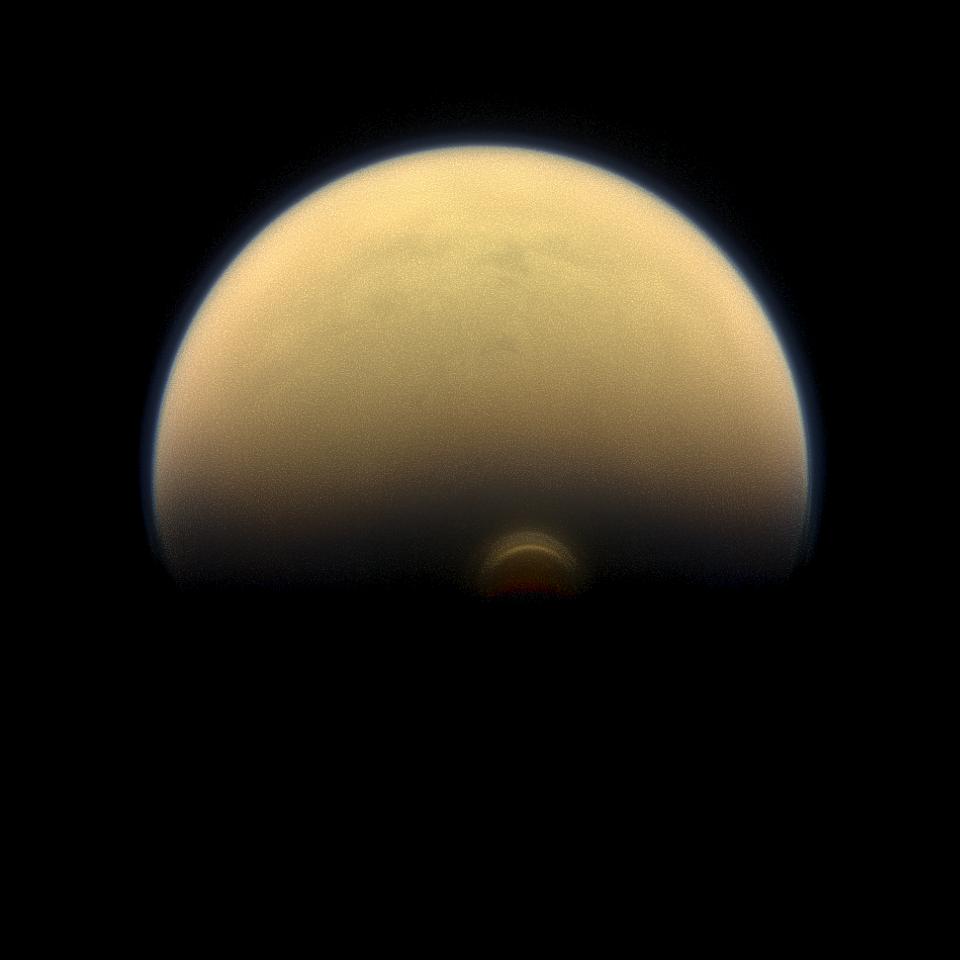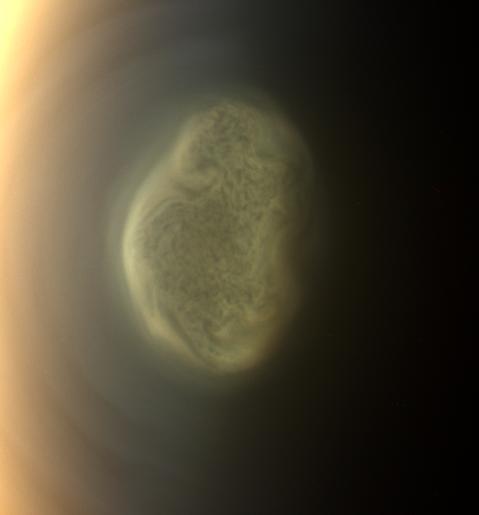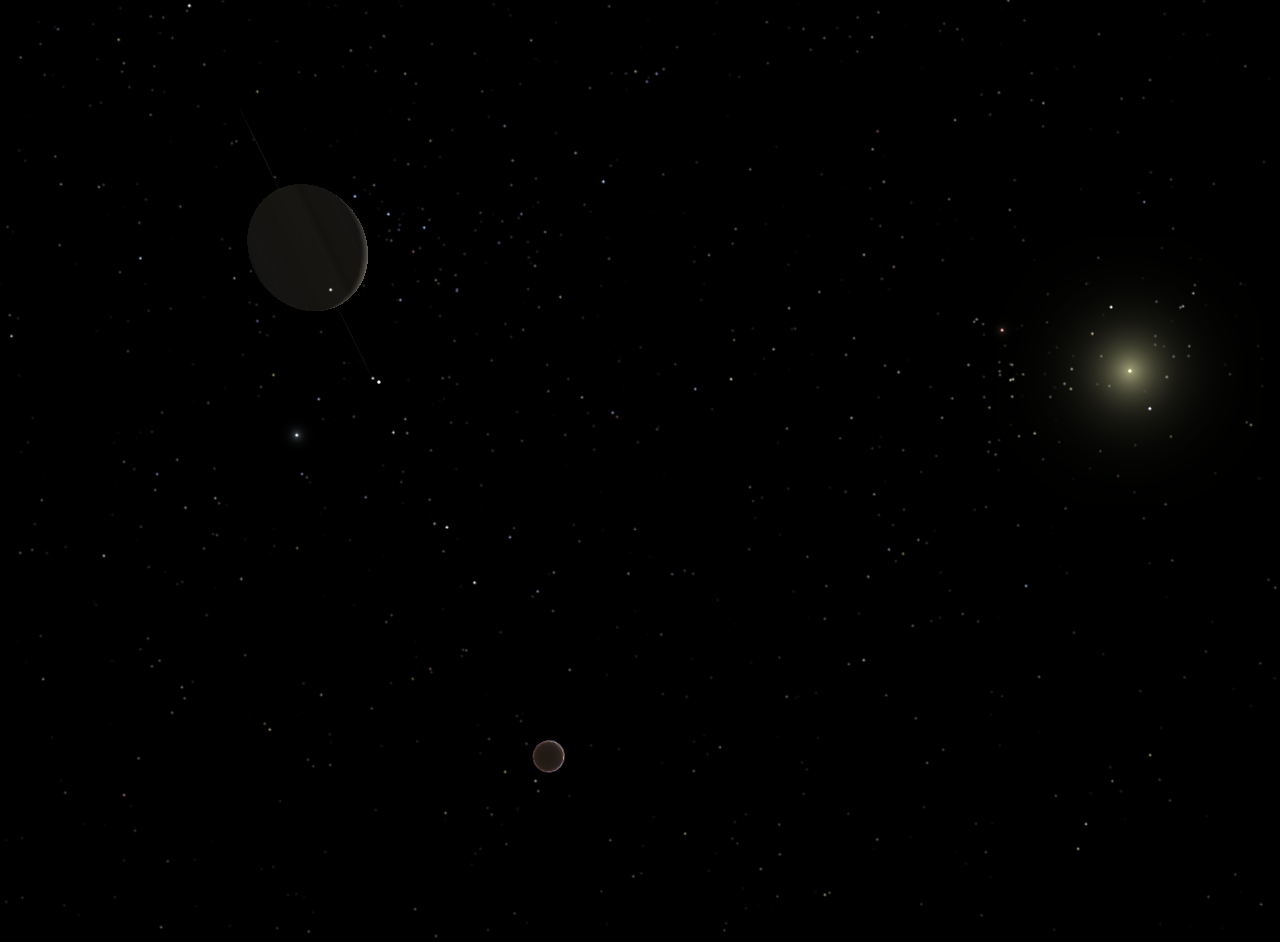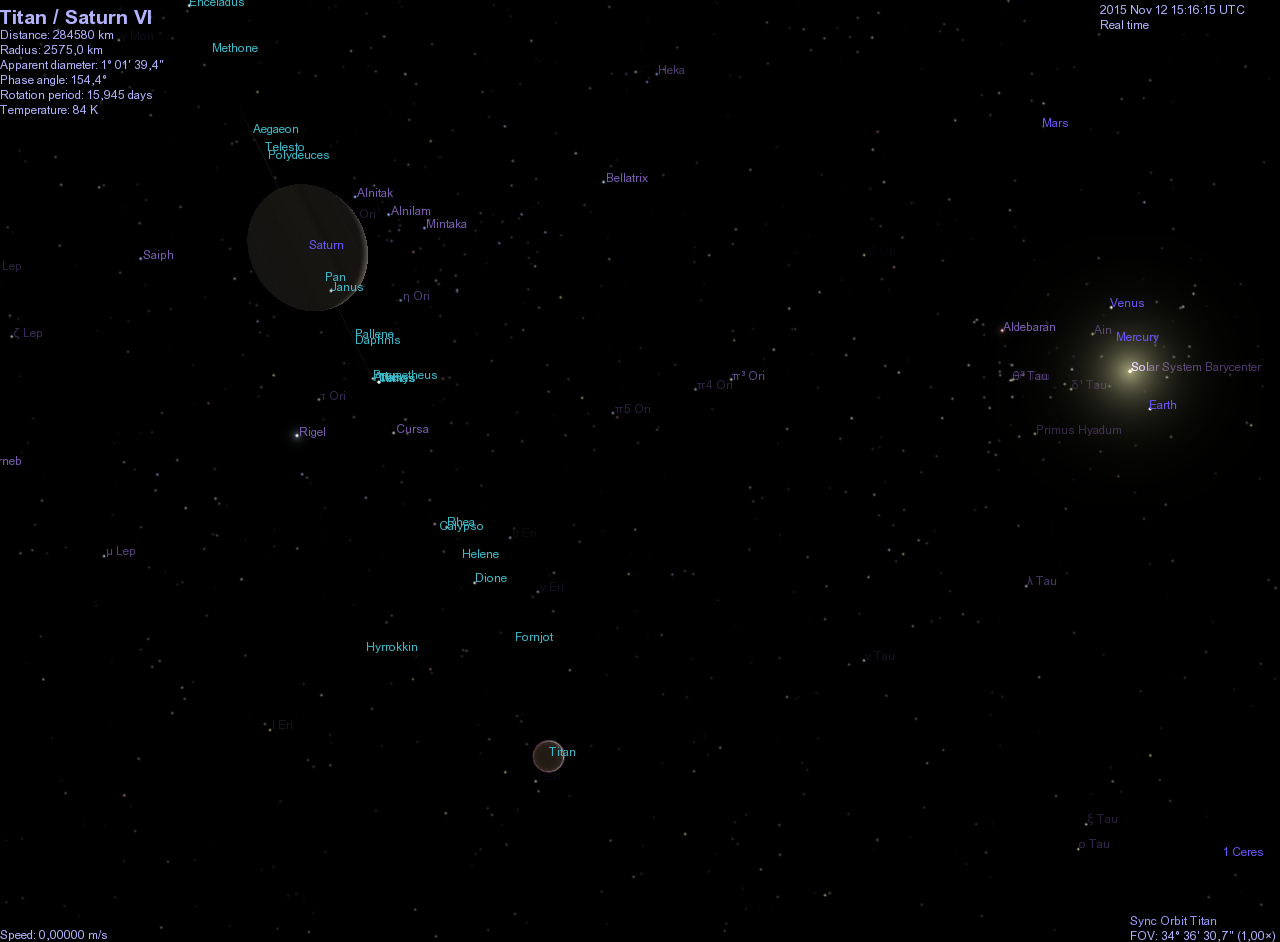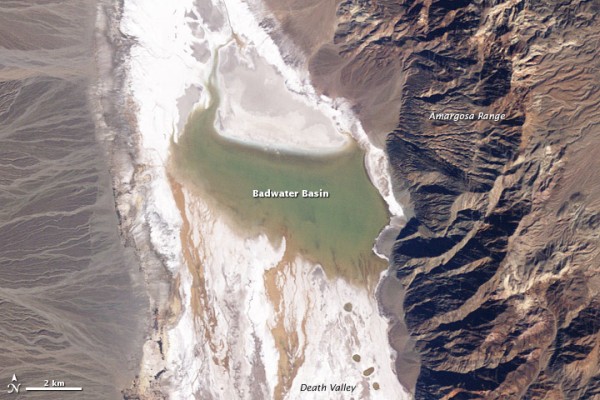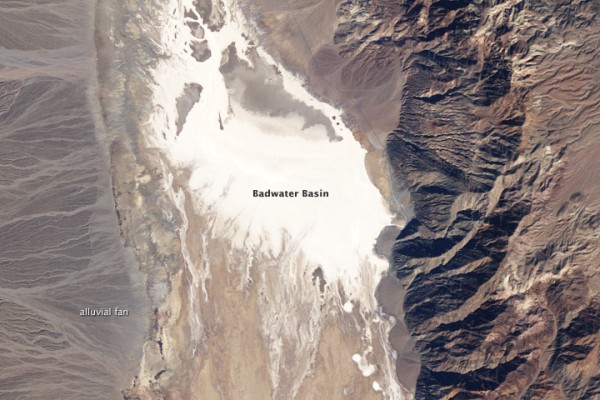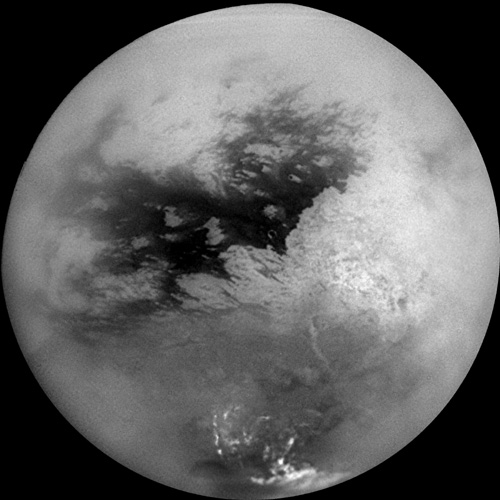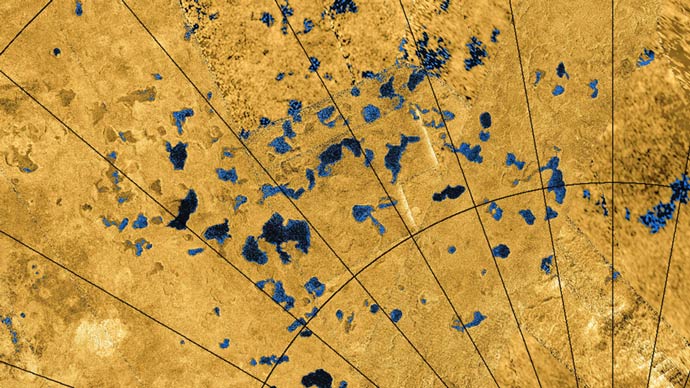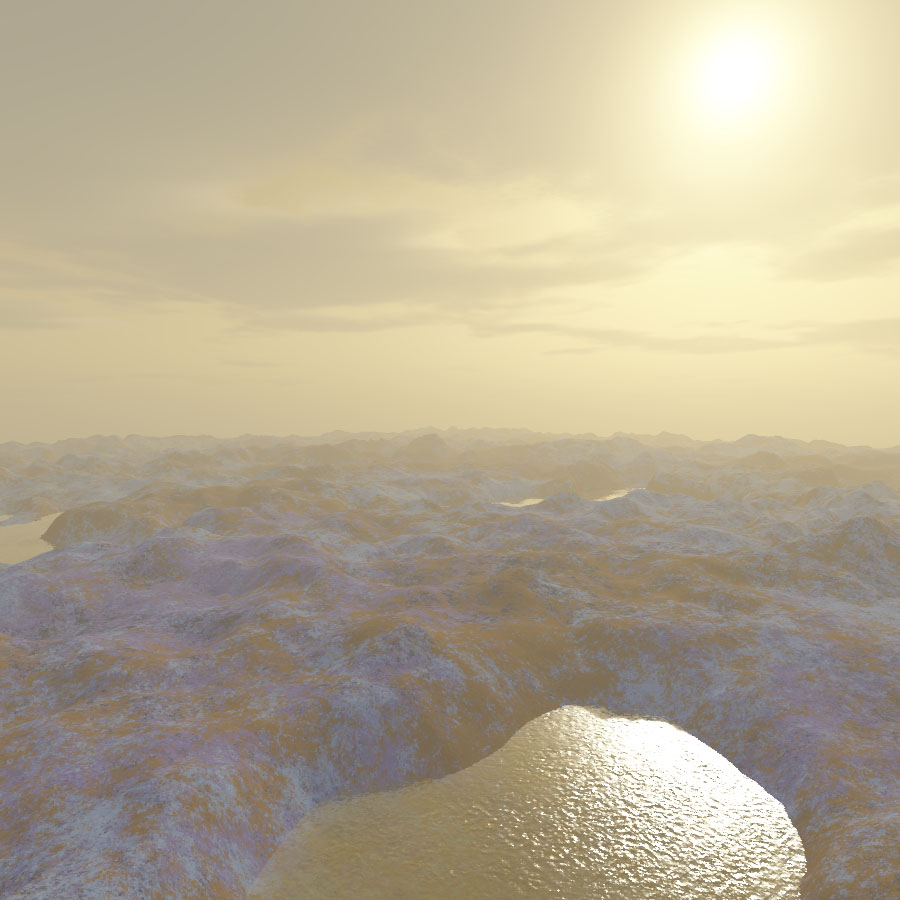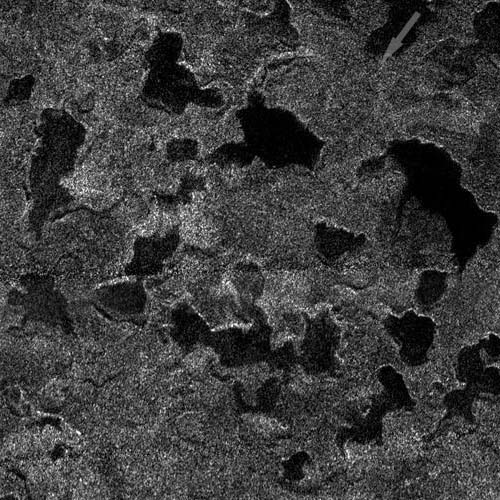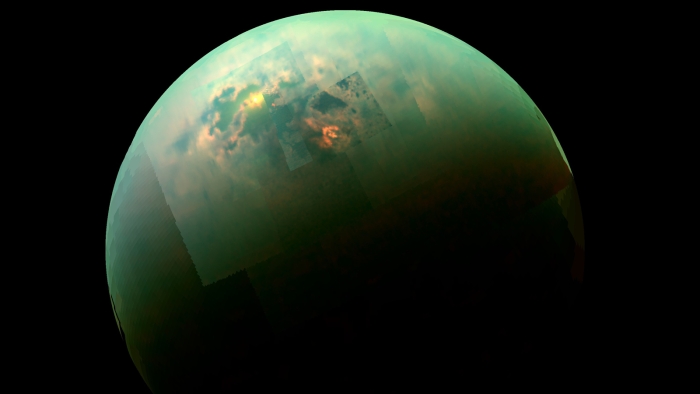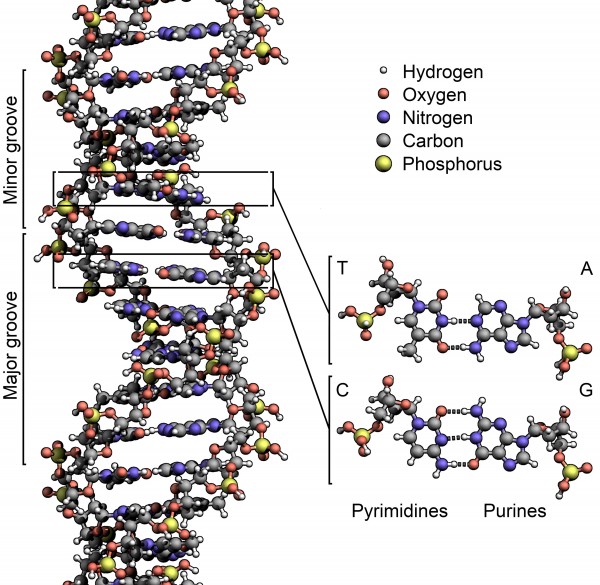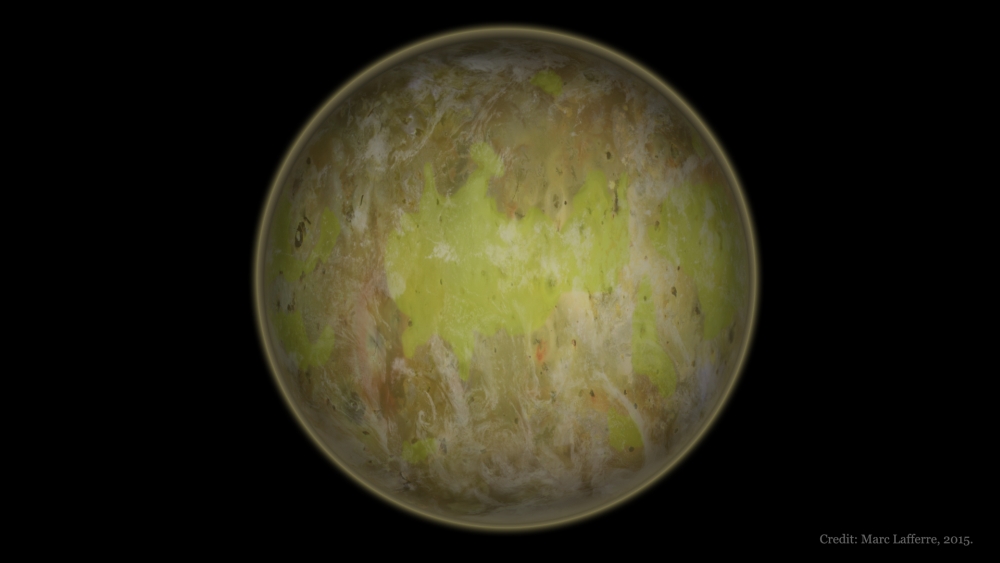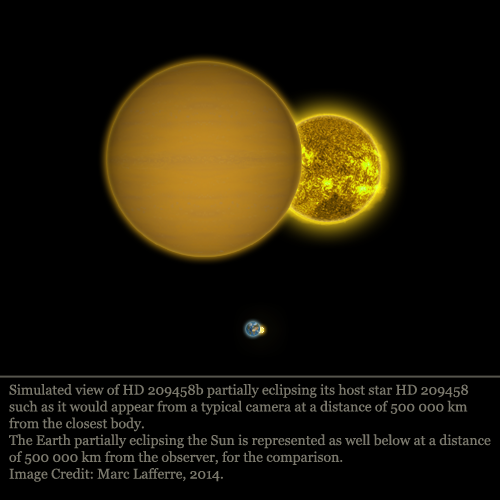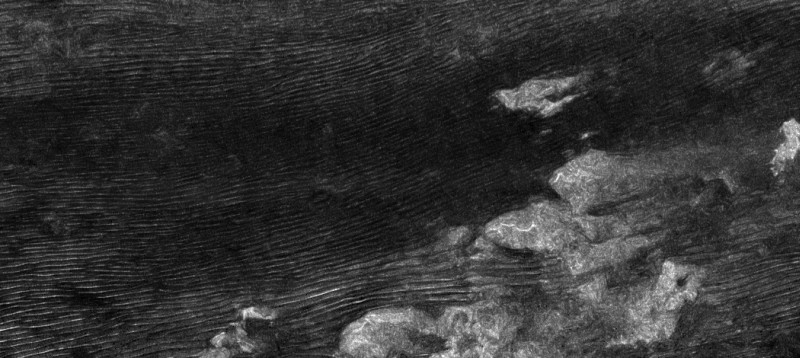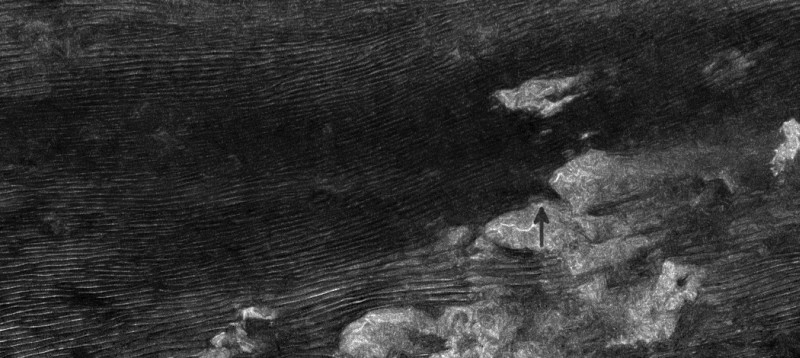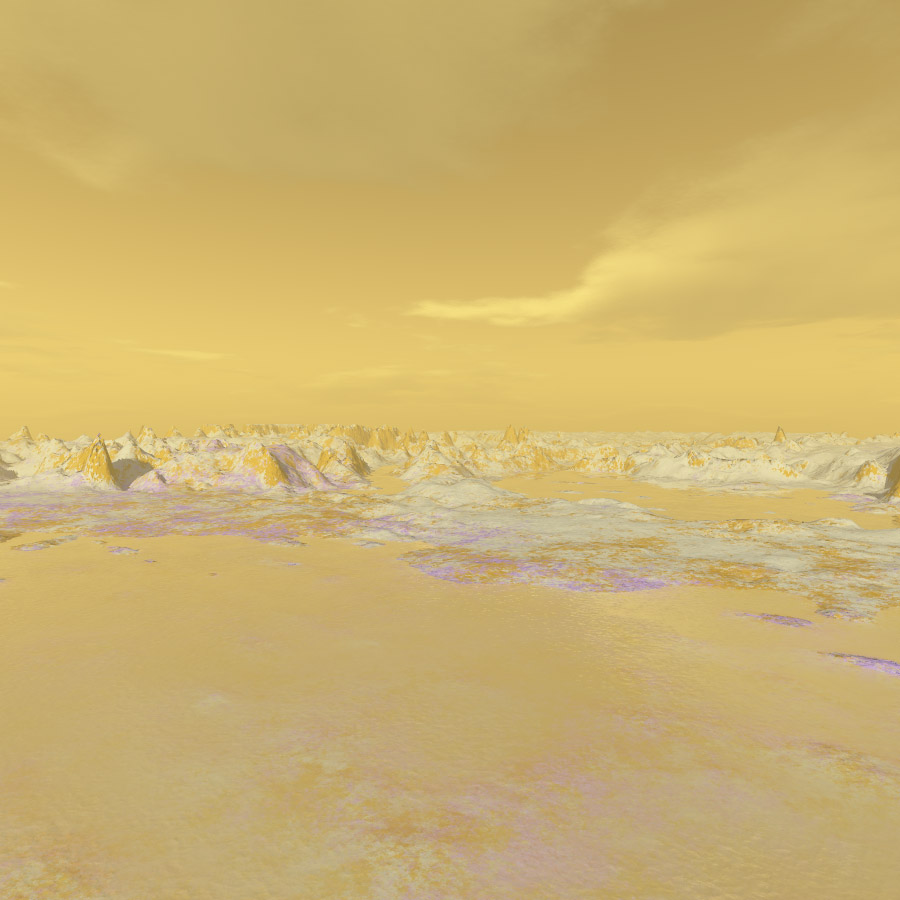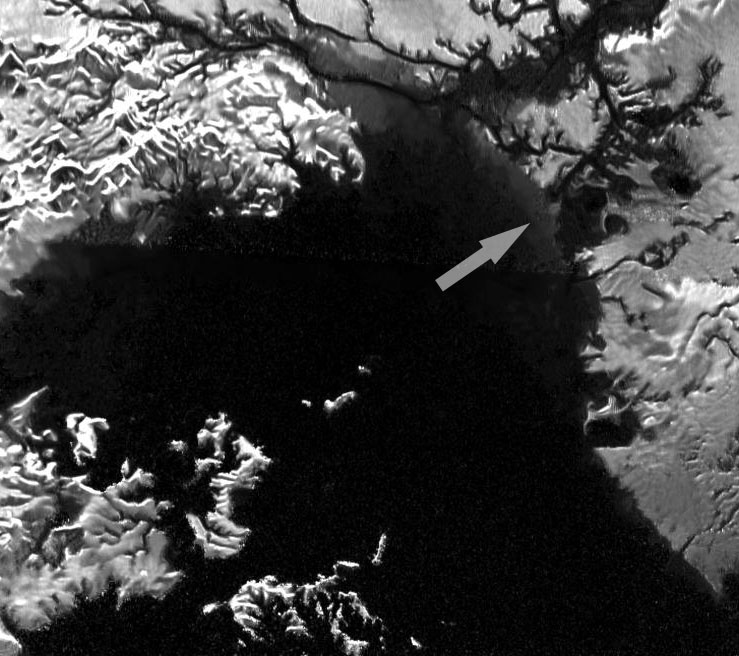Titan News 2015
November 12, 2015: A Giant Ice Cloud Identified in the Stratosphere Over Titan's South Polar Region With the Composite Infrared Spectrometer of the Cassini Probe
Since the arrival of the Cassini-Huygens probe into the Saturn System in 2004, researchers try to identify seasonal changes or phenomena on Saturn's largest moon Titan. The dynamics and the chemistry of Titan's atmosphere appear to be particularly complex. A Titanian year lasts approximately 29.5 Terrestrial years and a Titanian season lasts about 7.5 Terrestrial years.
The Cassini-Huygens spacecraft entered the Saturn System when the southern hemisphere was experiencing the Summer season. As a result, the northern hemisphere was experiencing the Winter season. Now, the northern hemisphere is experiencing the end of the Spring season whereas the southern hemisphere is experiencing the end of the Autumn season.
A remarkable cloud hovering over the south pole of the Orange Moon at an altitude of approximately 186 miles or 300 kilometers was identified in 2012 from the camera of the Cassini probe. That cloud developing in the stratosphere of the Opaque Moon was a clear sign of seasonal changes. Now, researchers have realized that this cloud was just the tip of the iceberg because a much more massive ice cloud system has been recently identified beneath this cloud, peaking at an altitude of approximately 124 miles or 200 kilometers.
The giant cloud can be found in the low-to-mid-stratosphere. This atmospheric region corresponds to a stable area above the troposphere where vertical air motions occur and where the meteorological activity is relatively strong. The new cloud identified from the Cassini probe appears to be composed of frozen compounds and it shows a low density, similar to our Terrestrial fog.
The monstrous ice cloud which was detected with the Composite Infrared Spectrometer or CIRS is likely flat on top. The Composite Infrared Spectrometer allows scientists to obtain profiles of the Titanian atmosphere at invisible thermal wavelengths. The data collected thanks to the instruments of the Cassini probe clearly unveil the seasonal transition from Fall to Winter in the south polar region of Titan. The phenomena observed in the stratosphere show that Winter is approaching like a lion in the south polar region. The Winter season will start in 2017 in Titan's southern hemisphere and the Cassini mission is expected to end in 2017.
The finding of the monstrous ice cloud was presented by Carrie Anderson at the annual Meeting of the Division of Planetary Sciences of the American Astronomical Society at National Harbor, Maryland on November, 11. Carrie Anderson who is part of NASA's Goddard Space Flight Center in Greenbelt, Maryland pointed out: "When we looked at the infrared data, this ice cloud stood out like nothing we've ever seen before." She added: "It practically smacked us in the face."
The formation process of the ice clouds found in the stratosphere over the polar regions of Titan is different from the well-known formation process of Terrestrial clouds. In the troposphere of the Earth, water can evaporate due to heating, rise and condense at an altitude where the environment is cold enough to allow condensation processes of water and the development of clouds. The formation of clouds on Earth is closely related to temperature and air pressure. Low pressure areas allow the development of clouds.
On Earth, one can encounter rain fall and snow fall depending on the environmental temperature. The troposphere of Saturn's largest moon also allows the development of clouds but the process of cloud development involves methane or ethane. Methane or ethane rain can occur on the exotic moon of Saturn. The polar ice clouds identified in the stratosphere of Titan obey a different process from the tropospheric clouds. They appear higher in the atmosphere and they are related to an atmospheric circulation whose network goes from pole to pole.
In this network, gases are transported from the pole in the warm hemisphere to the pole in the cold hemisphere. In the cold polar area, the warm air sinks. That's a phenomenon known as subsidence and the process can be compared to the process of water draining out of a bathtub. The gases which sink are composed of a mixture of smog-like hydrocarbons and nitriles. Nitriles are molecules comprising nitrogen atoms. The gases which form the ice cloud face colder and colder temperature as they go down. At lower and colder altitudes, different gases will condense at different temperatures, engendering a layering of clouds over a range of altitudes in the stratosphere.
The images or the data acquired from the Cassini spacecraft clearly suggest that the direction of the global circulation of the Opaque Moon is changing. The ice clouds which had been found in the north polar region have been disappearing whereas new ice clouds have been forming over the south polar region in parallel. That's a clear sign that Winter is approaching in the south polar region and that Summer is approaching in the north polar region.
Scott Edgington who is Cassini deputy project scientist at NASA's Jet Propulsion Laboratory (JPL) in Pasadena, California advanced: "Titan's seasonal changes continue to excite and surprise". He added: "Cassini, with its very capable suite of instruments, will continue to periodically study how changes occur on Titan until its Solstice mission ends in 2017."
The Cassini researchers need to analyze the dynamics of the polar ice cloud and to determine its composition, its altitude and its size in order to get a better idea upon the nature and the degree of severity of the Winter season in the south polar region. They had been in a position, on the basis of the ice cloud observed earlier from the eye of the Cassini spacecraft, to determine that environmental temperatures in the south polar region must go down to at least -238 degrees Fahrenheit or -150 degrees Celsius.
The ice molecules or particles of the monstrous cloud identified in the lower stratosphere where temperatures appear to be colder consist of a mixture of compounds made up of hydrogen, carbon and nitrogen atoms. Carrie Anderson and her team had identified the same signature or compounds in CIRS data regarding the north polar region but the signal appeared to be much weaker than that of the south polar cloud. Therefore, one can deduce that the onset of Winter is much harsher or dynamic than the end of Winter.
Robert Samuelson who is a Goddard scientist collaborating with Carrie Anderson pointed out: "The opportunity to see the early stages of winter on Titan is very exciting." He concluded: "Everything we are finding at the south pole tells us that the onset of southern winter is much more severe than the late stages of Titan's northern winter."
What will happen in the troposphere over Titan's south polar region ? Will the south pole encounter heavy rainfall ? Will Ontario Lacus enlarge as the Winter season develops in the area ? Many questions regarding the dynamics of Titan's meteorology remain.
The image above obtained from the Narrow-Angle Camera of the Cassini probe on July 30, 2013 clearly shows a yellow south polar vortex evolving high in Titan's deep atmosphere. That's probably a sign of significant seasonal changes in the area. Image Credit: NASA/JPL-Caltech/Space Science Institute.
The true color image above shows the enigmatic south polar vortex of Saturn's largest moon. The view combining images acquired using red, green and blue spectral filters was taken on June 26, 2012 with the Narrow-Angle Camera of the Cassini spacecraft. One can see in detail the complex structure of the swirling mass of gas. Image Credit: NASA/JPL-Caltech/Space Science Institute.
| The image in the upper part of the table corresponds to a computer-generated view of Titan and its neighborhood on November 12, 2015. The image which simulates the relative position of Titan in the Solar System was generated with the software Celestia. One can notice in particular the Gas Giant Saturn as well as the Sun. The image in the lower part of the table corresponds to the same view with key information upon the environment. Image Credit: Celestia, Marc Lafferre. |
- To get further information on that news, go to: http://saturn.jpl.nasa.gov/news/cassinifeatures/feature20151111.
July 30, 2015: "Bathtub Rings" and Apparent Evaporites at Low Latitudes on Titan Suggest the Presence of Ancient Lakes or Seas
A new study on evaporites reveals dry lakes and evaporites at low latitudes on Titan and suggests the presence of ancien lakes or seas in the equatorial or tropical regions of Saturn's largest moon. The work was led by Shannon MacKenzie, a graduate student in physics at the University of Idaho and the outcome of the analysis was published in the journal Icarus. The study was supported by the NASA Astrobiology Institute (NAI) element of the Astrobiology Program at NASA.
Since the arrival of the Cassini/Huygens spacecraft into the Saturn System in mid-2004, the specialists of Titan have been in a position to determine, on the basis of radar, infrared or near-infrared data, that lakes, seas and rivers are mostly concentrated in the polar areas of the Orange Moon. The high latitudes of the northern hemisphere appear to be damper than the high latitudes of the southern hemisphere and the equatorial or tropical regions appear to be dry with topographic or geological features representing dried-up lakes.
Some features at low latitudes clearly show signs of evaporation phenomena or evaporites and they are reminiscent of rings on a bathtub. The observations imply that the liquids on Titan may have progressively moved or shifted over time. Shannon MacKenzie pointed out: "Today, Titan's equatorial region is more like a desert --there is a huge sand sea of these phenomenal linear dunes and no lakes or seas."
Researchers are convinced that lakes, seas and rivers have existed in the equatorial area in the past due to signs of evaporites in particular. Evaporites correspond to a mineral sediment that appears concentrated and crystallized when the lakes, the puddles or the seas have evaporated. Any potential lifeform on Titan may be based on those surface liquids. Shannon MacKenzie argued: "Evaporites tell us where liquid has been in the past."
The seas, lakes or rivers on the Opaque Moon are dominated by methane and ethane. In the harsh environment of Titan, water can't appear in its liquid form. Water can only appear in its solid form. Evaporites will tend to generate a ring around their lake but that's not always the case. The formation of evaporites implies an isolated body of liquids with no tributaries and a significant amount of dissolved solid in the liquid. When the lake dries up via typical evaporation processes, the solid falls out and concentrates to form the structures we see.
On our planet, the evaporites are generally closely related to salts which dissolve in liquid water. Salts couldn't dissolve in the seas, lakes or rivers of Titan. As a result, the researchers advance that the composition of the evaporites is probably made of solid hydrocarbons and nitriles. Shannon MacKenzie who believes in this hypothesis pointed out: "The game is the same, but the players are different."
The Huygens probe which landed into the Adiri/Shangri-La region at low latitudes on January 14, 2015 obtained aerial views of dark channels in the bright hills of the area suggesting the presence of meteorological phenomena such as rainfall or evaporation processes. How often does it rain in the area ? Nobody knows ! But the images of the soil clearly revealed pebbles or rounded cobbles. The area where the Huygens probe landed is reminiscent of Terrestrial landscapes with drainage channels, hills, valleys or even fossil seas.
Shannon MacKenzie and her team analyzed Cassini images taken since the beginning of the mission in mid-2004 in order to identify hints of evaporites. The researchers were in a position to find 28 features spread across Saturn's largest moon. One can notice that many of the new deposits are located near existing bodies of liquid. However, the two largest single structures of evaporites are found in the equatorial regions implying the presence of ancient seas or lakes in this dry area where Seif Dunes can be observed.
Previous studies postulated that these regions may have been fossil seabeds that could have hosted a combined total of 57,000 cubic kilometers of ethane and methane. It's hard to imagine the appearance of those exotic evaporites because the Visual Infrared Mapping Spectrometer of the Cassini probe can only resolve features about 0.6 miles (1 kilometer) which is insufficient to identify the evaporites in detail. Shannon MacKenzie advanced: "It's really useful to develop an intuition for possible 'ground truths' --what you might see on the ground of your planet of study, should you be so lucky to go --by studying what happens on Earth."
Several forms of evaporites can be discerned on Earth as Shannon MacKenzie shows. She describes the structure at the Badwater Basin in Death Valley as "rough, like a sidewalk". By contrast, in the Devil's Golf Course region, a plain of evaporites, one can identify "crazy 1.5-foot-[0.5-meter] tall complicated structures, very rough and sharp." Shannon MacKenzie also mentioned the study of the salt plain of Salar de Uyuni in Bolivia which "is fairly flat from frequent resurfacing in the rainy season."
In the neighborhood of existing lakes or seas on Titan, the evaporites may take the form of "bathtub rings" on the rocks just above the existing waterline. That kind of rings can take shape around Terrestrial lakes as water levels drop. Let's point out however that the hypothesis of the rings remains "somewhat speculative" as Daniel Cordier, a research scientist at the French National Center for Scientific Research who was not involved in the research work, advanced. He argued: "If they exist, they could be much more chemically rich than similar structures observed on Earth, where they are composed mainly of calcium carbonate."
Shannon MacKenzie explained that when we have the possibility to obtain detailed data on the Titanian evaporites, "we may find something on the diverse spectrum of Earth evaporites, or maybe something totally unique to the chemistry and geology of Titan." The current distribution of lakes, seas and rivers on Titan is surprising and intriguing because the north polar region appears to be the most humid area of Titan and the low latitudes appear dry despite rare, transient rainfall events.
The discovery of evaporites at low latitudes by the team of Shannon MacKenzie implies that the locations of liquid on Titan may have changed over time. The migration of liquids may be closely related to changes in the seasons. During the revolution of Titan and Saturn around the Sun, the hemisphere capturing more direct sunlight changes over time. A Titanian year lasts approximately 29.5 Terrestrial years which implies complex seasonal changes.
The team of Shannon MacKenzie doesn't believe that the seasonal changes fully explain the massive changes observed. Strong movements of liquids from the north pole to the south pole have not been observed yet. Some researchers advance that over tens of thousands of years, the intensity of the Summer season may vary from pole to pole. The orbital shifts of the Orange Moon may imply that sometimes, the northern hemisphere captures more heat and that sometimes, the southern hemisphere receives more heat.
Shannon MacKenzie also mentioned another hypothesis related to the composition of the Titanian atmosphere. If the internal sources of methane are decreasing, the concentration of methane in the atmosphere and on the ground will also progressively decrease because the ultraviolet rays from the Sun continually destroy methane in the upper part of Titan's atmosphere. Shannon MacKenzie talks about the hypothesis of a "drying out state" on Titan. That's why the equatorial region may be getting drier and drier over time.
Shannon MacKenzie pointed out: "Whether or not that means there was more methane in the past to change the climate and allow or provide for more surface liquid is an area of active research." She argued: "Though our knowledge has made leaps and bounds since Cassini's arrival at the Saturnian system, we still don't fully understand Titan's hydrological cycle."
She concluded: "The evidence suggests that Titan is a dynamic, active--and certainly exciting--world." The presence of linear and parallel dunes extending over long distances in the dark areas of the low latitudes is consistent with the presence of ancient seas in that area. That's only an hypothesis but evaporites found at low latitudes clearly suggest a more humid past.
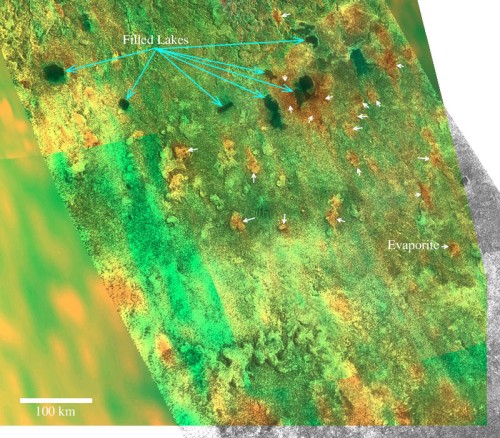
The image above shows a color view of an area south of Ligeia Mare where one can notice filled lakes as well as dry lakes unveiling evaporite. The blue arrows show filled lakes whereas the white arrows indicate the dry lakes appearing brown in this mosaic. The image was produced on the basis of VIMS and radar data obtained from the Cassini probe during its journey in the Saturn System. Image Credit: NASA/JPL/UA.
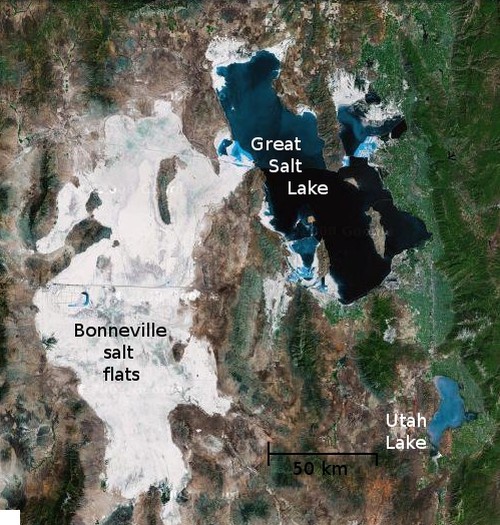
The image above corresponds to a Google Map view of the Great Salt Lake which is surrounded by a significant evaporite deposit. One can also notice the salt desert of Bonneville salt flats which used to be a lake long ago.
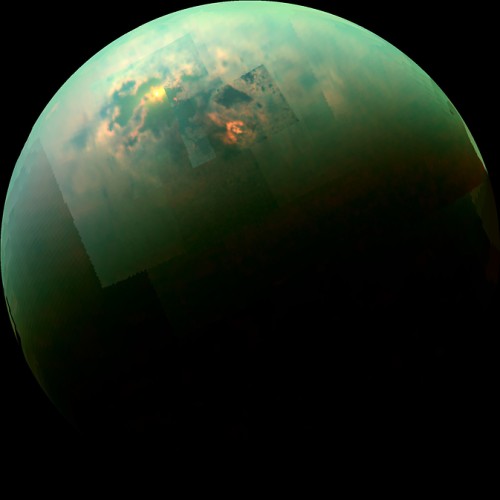
This global mosaic shows a glint in the most humid area on Titan found in the north polar region. One can clearly notice the lakes or seas as well as the orange rims or coasts. Image Credit: NASA/JPL-Caltech/University of Arizona/University of Idaho.
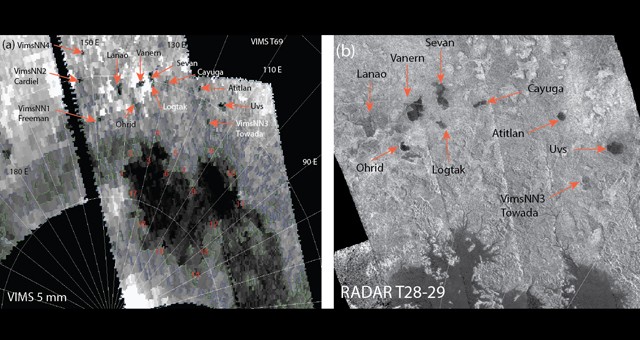
The mosaic of images above shows some north polar lakes or seas. One can see on the left one of the large seas and a pleiade of small lakes. One can notice on the right several small lakes as well as a portion of a sea. The left view was produced on the basis of VIMS data and the right view was generated on the basis of radar data. Image Credit: NASA/JPL-Caltech-University of Arizona.
|
|
|
|
| The images of this table show the area of Lake Badwater in California's Death Valley. The upper view unveils Lake Badwater when it experienced rainfall in 2005. Two years later, the water content had completely evaporated leaving behind new deposits of salts. The markings produced by those new deposits represent evaporite. The methane or ethane lakes or seas on Titan may produce that kind of marking when they evaporate. Credit for the images: NASA views by Robert Simmon, based on Landsat data from the USGS Global Visualization Viewer. |
- To get further information on that news, go to: http://www.astrobio.net/news-exclusive/bathtub-rings-suggest-titans-dynamic-seas.
June 30, 2015: Some Researchers Suggest that the Atmosphere of the Early Titan Was Almost Entirely Composed of Nitrogen Engendering Lakes of Liquid Nitrogen
A team of researchers involving Benjamin Charnay who is now a post-doctoral researcher at the University of Washington suggests that the atmosphere of the Early Titan was almost entirely composed of nitrogen and that methane was absent or almost absent in the atmosphere of this primitive gas blanket.
The group of scientists also hypothesized that the environmental temperature at the level of the surface was weaker due to the absence of the current greenhouse effect produced by methane molecules present in a relatively large proportion in the Titanian atmosphere today. The weaker environmental temperatures of the Early Titan were likely to allow condensation processes of nitrogen in the primitive atmosphere, the development of nitrogen clouds as well as rainfall of nitrogen. Therefore, there were probably lakes, seas or rivers of nitrogen on the surface of the Early Titan.
The research work suggesting the existence of an atmosphere almost entirely composed of nitrogen on the Early Titan was recently published in the journal Icarus and was entitled "Titan's past and future: 3D modeling of a pure nitrogen atmosphere and geological implications."
The atmosphere of Saturn's largest moon, today, probably resembles the atmosphere of the Early Earth. As a result, it represents, to a certain extent, a prebiotic natural laboratory because this exotic environment is roughly similar to the environment that led to the development of life on our planet.
The Titanian atmosphere is mostly composed of molecular nitrogen and nitrogen represents about 95 percent of its composition. Methane is the second most abundant gas present in this exotic atmosphere with a proportion which can be as high as 5% of its composition. And the concentration of methane appears to be higher near the surface.
The methane molecules evolving in Titan's atmosphere tend to engender a slight greenhouse effect. In other words, the environmental temperature at the level of the ground would have been lower without the current greenhouse effect engendered by methane. The average temperature on the surface is around -292 degrees Fahrenheit, -180 degrees Celsius or 93 Kelvin.
This harsh environment allows the presence of methane and ethane in their liquid form. A methane and ethane cycle on Titan has been revealed with evaporation processes, condensation processes and precipitation processes. Lakes, seas, rivers, cloud systems or cyclones have been clearly identified on Titan. Without the greenhouse effect produced by methane, the methane would rather freeze at the surface. Without any liquid or solvent, life is not expected to develop or emerge.
The origin of methane on Titan remains a mystery but there may be internal sources and photochemical processes in the atmosphere may engender methane molecules. The origin of methane on Earth is found in biological processes as well as in volcanoes. Researchers believe that the Titanian methane is less than a half billion years old. That's why the primitive atmosphere of Titan may have been almost exclusively composed of nitrogen. The surface pressure was likely similar to the current surface pressure but the greenhouse effect was likely weaker as Benjamin Charnay suggested.
Benjamin Charnay who was a planetary scientist who worked at the Laboratory of Dynamic Meteorology at the P&M Curie University in France when the study was led pointed out: "Looking at Titan's past helps us to understand where the methane comes from and how the photochemistry evolved." He advanced: "The photochemistry in Titan's past with less atmospheric methane may have been closer to the atmospheric chemistry on the early Earth that could have led to the emergence of life."
Today, the meteorological phenomena on Titan are related to methane and most lakes, seas and rivers appear in the high latitudes of the Orange Moon. Benjamin Charnay believes that if methane had been present on Titan approximately four billion years ago, there would be a higher amount of liquid methane or ethane today with bigger lakes or seas than what we observe in radar images today.
The team of Benjamin Charnay resorted to a model called Generic LMDZ to simulate the global climate of the Opaque Moon in its youth. The researchers postulated that the atmosphere of Titan was almost entirely composed of nitrogen at the beginning. This model had already been used to simulate the early climate of our planet or even climates of exoplanets.
They realized that the absence of methane removes or strongly lowers the greenhouse effect and implies significant climate changes on Titan. The model showed that the atmosphere cooled and condensed, generating nitrogen clouds and polar seas of liquid nitrogen. It also unveiled that at the poles, the nitrogen atmosphere froze.
A high level of reflectivity from liquid nitrogen could engender a freezing phenomenon like on Neptune's largest moon Triton but that configuration may be unlikely on the Early Titan. Benjamin Charnay and his collaborators believe that there were lakes, seas or rivers of nitrogen on the Early Titan because it could simply account for the erosional processes observed today like the sinuous channels or the valley networks.
Benjamin Charnay argued: "Liquid nitrogen could erode the surface much more efficiently than liquid methane, producing valley networks and removing the impact craters which are used to estimate the age of the surface." He pointed out: "On Titan, we currently see valley networks, but we don't know exactly how they formed."
Methane, ethane, propane or nitrogen in their liquid form can obviously play a key role in eroding or sculpting the landscape of Titan. The strong role of nitrogen in erosional processes remains hypothetical. Benjamin Charnay advanced: "Titan's climate is quite dry today, with little methane precipitation. The formation of valley networks is challenging for such conditions. Researchers believe that Titan was wetter in the past, with more methane rain explaining the formation of valley networks. It is a reasonable scenario. But we believe that liquid nitrogen could also have played a significant role."
The remarkable flattening of Titan's poles may be closely related to infiltration of liquid nitrogen into the crust implying an increase in the density of the crust. This rise in the density at the level of the poles may have triggered a flattening of the poles.
The analysis of the atmospheric composition and dynamics allows researchers to speculate on the possibilities of life on other planets or moons. Can there be microbes or more evolved lifeforms on Titan ? That's unlikely because water can't appear in its liquid form on the surface.
Likewise, the presence of microbes in the methane or ethane lakes and seas of Titan is unlikely. However, an internal ocean of methane and water may exist beneath the surface of Titan. Can there be life in this hypothetical subsurface ocean ?
Benjamin Charnay advanced: "This could also be true of the oceans of the moons of Ganymede and Europa at Jupiter, and maybe Enceladus at Saturn as well." The team of Benjamin Charnay claims that, in the long term, the methane present in the orange atmosphere of Titan will have been completely destroyed by chemical reactions occuring in the atmosphere.
Therefore, the greenhouse effect produced by methane will have disappeared and the atmosphere will become colder allowing the presence of nitrogen clouds or nitrogen seas, lakes or rivers. The researchers will continue to study the Titanian atmosphere to better understand its origin, its past and to anticipate what may happen in the future.
The image above reveals an infrared or near-infrared view of the disk of Saturn's largest moon Titan obtained from the Cassini probe during its campaign in the Saturn System. The dark areas found at low latitudes are dominated by Seif Dunes. One can clearly notice some bright clouds in the south polar area of the Opaque Moon. Image Credit: NASA/JPL/Space Science Institute.
The image above corresponds to a radar view revealing a branching network of rivers or drainage channels in the high latitudes of Titan. The radar portion was obtained from the Radar Mapper of the Cassini spacecraft during its tour in the Saturn System. The climate model proposed by the team of Benjamin Charnay suggests that liquid nitrogen could have strongly eroded or sculpted the landscape long ago generating river valleys or depressions for instance. Image Credit: NASA/JPL-Caltech/ASI.
- To get further information on that news, go to: http://www.astrobio.net/news-exclusive/early-titan-was-a-cold-hostile-place-for-life.
June 22, 2015: Dissolution Processes Engendering Depressions, Caves, Lakes or Sinkholes May Occur on Titan
A new study led by Thomas Cornet of the European Space Agency and recently published in the Journal of Geophysical Research, Planets shows that dissolution processes may play a key role in the development of the lakes we observe in the high latitudes of Titan where conditions are relatively damp or humid. The research work which shows how the depressions, the sinkholes or the caves can form is based on data acquired from the Cassini probe which is the outcome of a collaboration between NASA, the European Space Agency (ESA) and the Italian Space Agency.
The radar data taken from the Radar Mapper of the Cassini probe have clearly revealed that the high latitudes or the polar regions of Saturn's largest moon host lakes, seas, rivers or topographic depressions which are likely closely linked to meteorological phenomena. The north polar region appears to be the dampest area on Titan.
Kraken Mare located in the high latitudes of the northern hemisphere is the largest body of surface liquids on Titan. One can also mention Ligeia Mare and Punga Mare which are remarkably big lakes in the north polar region. The south polar region appears to be less damp. Ontario Lacus is the largest body of surface liquids in the southern hemisphere. Let's point out that Ontario Lacus was the first sea or lake identified on Titan.
Researchers have clearly observed that cloud systems can take shape and rapidly dissipate in the polar areas. That implies that the well-known meteorological processes of evaporation, condensation and precipitation occur on the Opaque Moon. The lakes, seas or rivers are likely composed of hydrocarbons and more precisely of a mixture of methane and ethane.
The environmental conditions on Titan are particularly harsh since the temperature at the surface is around minus 292 degrees Fahrenheit, minus 180 degrees Celsius or 93 Kelvin. At this temperature, methane, ethane and propane can appear in their liquid form and water is obviously in its solid form. A parallel can be easily drawn between the water cycle on Earth and the methane cycle on Titan.
Researchers have been surprised to see some apparently steep depressions on Titan. One of the main questions is how the topographic depressions observed on the surface have been formed. Thanks to its deep and thick atmosphere and the erosional processes generated by meteorological phenomena, Titan unveils remarkable landscapes and appears to be the second body in the Solar System known to host stable liquids or lakes and seas on its surface.
Researchers have been in a position to establish a typology of lakes, seas and depressions. Two types of methane-and ethane-filled depressions producing distinctive features near the poles have been distinguished. One can identify, first, large seas several hundred miles or kilometers across and up to several hundred feet or meters deep connected to branching channels. The channels are likely rivers related to meteorological phenomena. Secondly, a myriad of small dark patches or lakes can be observed in the flat regions. The small patches are shallower lakes made of rounded edges and steep rims. Some patches or depressions are apparently empty and seem to have been sculpted by erosional processes or dissolution phenomena.
Researchers try to understand the dynamics and the origin of the lakes, seas and rivers. They are convinced that rainfall plays a key role but an underground network may also fuel some lakes or seas. The small lakes which are not fed by rivers may be fueled, partially or fully, by liquid methane or ethane coming from the underground. Some lakes may be seasonal since some topographic depressions appear completely empty.
A season on Titan lasts approximately seven Terrestrial years and a Titanian year is about 29.5 Terrestrial years. Due to the inclination of the rotational axis of Titan and to the variation in the distance of Titan from the Sun, the dynamics of Titan's meteorology can change significantly during a Titanian year and new lakes can form or enlarge. But scientists admit that the dynamics of lakes and seas is still poorly understood.
The team of Thomas Cornet noticed that Titan's lakes are reminiscent of the karstic landforms on our planet. The karstic landforms are the outcome of erosion of dissolvable rocks in groundwater and rainfall infiltrating through rocks. Limestone and gypsum are well known rocks which can dissolve, erode and engender caves or subsurface lakes or rivers. Dissolution and erosion can produce surprising landscape features on Earth such as dolines, sinkholes, caves in humid climates or salt pans where conditions are particularly dry. The analysis of these phenomena can tell us a lot about what's happening on Titan.
The researchers believe that, even if the strength of the erosion or the dissolution is different on Titan and on Earth, the features engendered by these processes may be surprisingly similar. They must consider, in their analysis, key factors or parameters such as the rate of erosion, the chemistry of the rocks, the rainfall rate and the surface temperature.
In their simulations or calculations, the researchers resorted to prevailing models of Titan's climate and they assumed that the surface of the Orange Moon is covered in solid organic material and that the main dissolving liquid is composed of hydrocarbons. Thus, they were in a position to calculate how long it would take for surface patches to dissolve to produce the depressions or the lakes observed in radar views. The team of Thomas Cornet concluded that around 50 million years are needed to generate a 300-foot or 100-meter depression in the relatively rainy polar regions of the Opaque Moon. The outcome is consistent with the youthful age of the Titanian ground.
Thomas Cornet pointed out: "We compared the erosion rates of organics in liquid hydrocarbons on Titan with those of carbonate and evaporite minerals in liquid water on Earth." He concluded: "We found that the dissolution process occurs on Titan some 30 times slower than on Earth due to the longer length of Titan's year and the fact it only rains during Titan summer. Nonetheless, we believe that dissolution is a major cause of landscape evolution on Titan and could be the origin of its lakes."
The researchers realized that at lower latitudes, where the rainfall level is particularly low compared to the polar areas, the erosional and dissolution processes are largely weaker which explains why there is a relative absence of depressions at low latitudes. Their calculations upon the development of lake depressions at lower latitudes revealed a much longer timescale of 375 million years. In reality, Seif Dunes dominate the dark areas found at low latitudes on Titan.
Thomas Cornet advanced: "Of course, there are a few uncertainties: The composition of Titan's surface is not that well constrained, and neither are the long-term precipitation patterns, but our calculations are still consistent with the features we see today on Titan's relatively youthful billion-year-old surface." The comparative analysis of Titan's landscape features and Earth's landscape features allows us to better understand the dynamics of Titan's topography.
Nicolas Altobelli who is the ESA's Cassini project scientist argued: "By comparing Titan's surface features with examples on Earth and applying a few simple calculations, we have found similar land-shaping processes that could be operating under very different climate and chemical regimes." He advanced: "This is a great comparative study between our home planet and a dynamic world more than a billion kilometers away in the outer solar system."
Many questions remain regarding the origin of the lakes or the nature of the liquids but models or simulations help us raise new hypotheses. There is no doubt that the meteorology and rainfall play a key role in the formation of lakes but the hypotheses regarding internal sources must not be ruled out.
The view above corresponds to a portion of a global mosaic of Titan revealing a multitude of lakes or topographic depressions in the high latitudes of the northern hemisphere of Saturn' largest moon. The image is in fact a colorized view based on radar data obtained from the Radar Mapper of the Cassini probe during its orbital danse in the Saturn System. The blue patches in this view are likely lakes composed of a mixture of methane and ethane. Some patches which appear dark yellow may be dried-up lakes. Image Credit: NASA/JPL-Caltech/ASI/USGS.
| The image in the upper part of this table reveals a
simulated view of the north polar region of Titan where a myriad of
lakes or topographic depressions can be clearly identified. The
erosional processes may be strong in this area and some topographic
depressions may result from dissolution processes engendered by liquid
hydrocarbons. A parallel can be drawn with the karstic terrain on our
planet. A grey arrow was incorporated into the original radar view shown
in the lower part of the table to indicate the orientation of the
virtual camera unveiling the artist's representation of this land of
lakes and depressions. The original radar image is a portion of a radar
swath obtained with the Radar Mapper of the Cassini probe on October 9,
2006. Credit for the artist's representation:
Marc Lafferre, 2015. |
- To get further information on that news, go to: http://saturn.jpl.nasa.gov/news/cassinifeatures/feature20150619.
June 20, 2015: Researchers Show that Titan's Atmosphere Constantly Loses Some Hydrocarbons and Nitriles Due to a Widespread Polar Wind
A team of researchers led by Andrew Coates at University College London shows how a widespread polar wind on Titan engenders the expulsion of hydrocarbons and nitriles from the top of the atmosphere into space. The study of the team was recently published in the journal Geophysical Review Letters (GRL) and was entitled "A new upper limit to the field-aligned potential near Titan".
The specialists of Saturn's largest moon regularly find similarities between atmospheric or meteorological processes on Earth and on Titan and this time they have noticed that the process they describe is very similar to the configuration of polar winds on our planet. The researchers based their analysis on data obtained over seven years by the Cassini spacecraft which entered the Saturn System in mid-2004. They were in a position to analyze the interactions between the atmosphere of the Opaque Moon and the solar magnetic field and radiation. A wind of hydrocarbons and nitriles is generated. This wind tends to push molecules from the top of the atmosphere into outer space.
Titan has always been regarded as a prebiotic laboratory because the thick, deep and opaque atmosphere of the Orange Moon probably resembles the atmosphere of the Early Earth. The Titanian atmosphere is mainly composed of molecular nitrogen and methane is the second most abundant compound. Titan has a rocky surface and a significant atmosphere like Earth and Venus.
Cloud formations occur on Titan via evaporation and condensation processes. Like on Earth, rainfall or even snowfall can be encountered on Titan. Seas, lakes, rivers, canyons and Seif Dunes have been clearly revealed in radar images acquired from the Radar Mapper of the Cassini probe. Titan is the second largest moon in the Solar System and is bigger than Mercury.
Thanks to the numerous flybys of Titan performed by the Cassini probe since its arrival into the Saturn System in mid-2004, a huge amount of data regarding the Titanian atmosphere and the ground has been collected and analyzed. The Huygens probe which landed onto Titan on January 14, 2005 also gathered precious data regarding the profile of the Titanian atmosphere. The Cassini spacecraft is equipped with multiple instruments and one of the instruments, the Cassini Plasma Spectrometer or CAPS which was used in the research work was partly designed at UCL.
Andrew Coates who works at the UCL Mullard Space Science Laboratory pointed out: "Titan's atmosphere is made up mainly of nitrogen and methane, with 50% higher pressure at its surface than on Earth." He advanced: "Data from CAPS proved a few years ago that the top of Titan's atmosphere is losing about seven tonnes of hydrocarbons and nitriles every day, but didn't explain why this was happening. Our new study provides evidence for why this is happening."
Hydrocarbons are widespread on Titan. Methane, ethane, propane or acetylene can be encountered from the ground to the atmosphere. They have different chemical formulas but they are exclusively made up of carbon and hydrogen. Hydrocarbons can also be found on Earth in the form of natural gas, petrol or bitumen. Nitriles which have been clearly identified in the atmosphere of Titan are composed of hydrogen, carbon and nitrogen which are tightly bound together. Hydrogen cyanide or HCN is a well-known nitrile.
The work of Andrew Coates and his team appearing in the journal Geophysical Research Letters shows how the Titanian atmosphere loses some gas. The atmospheric loss is closely related to a polar wind which results from the interaction between solar radiation, the solar magnetic field and the molecules evolving in the upper atmosphere.
Andrew Coates argued: "Although Titan is ten times further from the Sun than Earth is, its upper atmosphere is still bathed in light." He explained: "When the light hits molecules in Titan's ionosphere, it ejects negatively charged electrons out of the hydrocarbon and nitrile molecules, leaving a positively charged particle behind. These electrons, known as photoelectrons, have a very specific energy of 24.1 electronvolts, which means they can be traced by the CAPS instrument, and easily distinguished from other electrons, as they propagate through the surrounding magnetic field."
The giant moon Titan has no intrinsic magnetosphere or magnetic field unlike our planet. The Opaque Moon undergoes the influence of the strong magnetic field of Saturn which rotates at a rapid pace and which drapes forming a comet-like tail around Titan. The Cassini Plasma Spectrometer (CAPS) performed some measurements in 23 flybys which went through Titan's ionosphere or its magnetic tail. The instrument detected measurable quantities of the photoelectrons up to 6.8 Titan radii away from Titan. These photoelectrons can move and easily follow the magnetic field lines.
The researchers noticed that these negatively-charged photoelectrons, covering Titan's ionosphere and the tail, form an electrical field. The electrical field appears to be strong enough to pull the positively charged hydrocarbon and nitrile particles or molecules from the Titanian atmosphere throughout the portion of the atmosphere illuminated by the Sun, engendering the widespread polar wind that researchers have identified there.
This phenomenon is well known on Earth and is closely related to the relatively strong magnetic field of our planet which is open in the polar regions letting some oxygen ions escaping into space. Due to the absence of a proper magnetic field on Titan, the phenomenon involving solar radiation, the environmental magnetic field and ionization processes can take shape over wider areas and not just near the poles.
This phenomenon involving polar winds can occur in the atmosphere of planets devoid of any significant magnetic field like Mars and Venus which are not so different from the Earth. Despite the harsh environment of Titan, where the solar energy reaching the Titanian atmosphere is remarkably weak, the dynamics of Titan's atmosphere with clouds, cyclones, winds or ionization processes continues to surprise us with familiar phenomena.
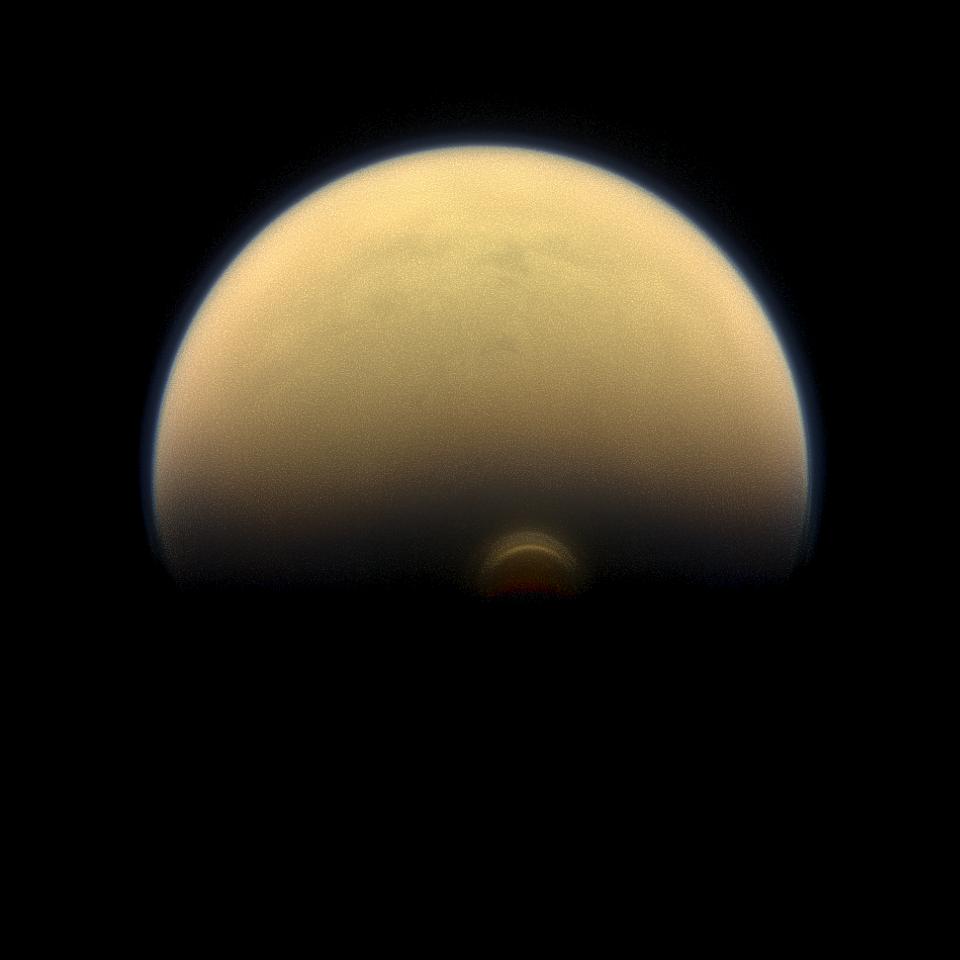
The image above corresponds to a natural color view of the Opaque Moon Titan produced on the basis of images taken using red, green and blue spectral filters. The view was obtained from the Narrow-Angle Camera of the Cassini probe on July 30, 2013. One can notice in particular the famous south polar vortex. The interaction between sunlight, the solar magnetic field and the atmospheric compounds engenders winds of hydrocarbons and nitriles. During that process, some material from the atmosphere can escape into space via magnetic and ionization phenomena. Image Credit: NASA/JPL-Caltech/Space Science Institute.
- To get further information on that news, go to: https://www.ucl.ac.uk/mathematical-physical-sciences/maps-news-publication/maps1535.
May 13, 2015: A New Study Suggests that Ether Molecules Could Act Like DNA On Oily Planets or Moons
The exploration of Titan via the Cassini-Huygens mission has allowed us to demonstrate that there can be other stable solvents than water on the surface of other worlds. In the high latitudes or in the polar regions of Titan, one can encounter lakes, seas or rivers of methane or ethane. Could we find an exotic lifeform in that kind of environment ?
In the harsh environment of Saturn's largest moon Titan, the environmental temperature turns around -180 degrees Celsius, -292 degrees Fahrenheit or 93 Kelvin. So, water can only appear in its solid form and any water-based life seems impossible because there is no liquid water on the surface of the Orange Moon. If there is a lifeform on Titan, the organisms may be based on liquid hydrocarbons and more precisely on liquid methane or liquid ethane.
Life on Earth is mostly composed of water and carbon and is based on DNA and RNA which are molecules containing the genetic code of life. Proteins which are combinations of amino acids perform the instructions provided by DNA molecules. The genetic changes in the DNA allow changes or evolution and lead to diversity and complexity. Any lifeform on Titan may not be based on the conventional DNA or RNA we encounter on Earth due to the harsh environment and mobility problems.
A new study led by Steven Benner, a distinguished fellow at the Foundation for Applied Molecular Evolution, a private scientific research organization located in Alachua, Florida suggests that compounds called ethers which don't play any role in any genetic molecules on our planet could form an exotic DNA on planets or moons with hydrocarbon oceans. The researchers of the study advance that ethers may act as genetic code molecules on warm Titans, Titan being too cold for that kind of DNA to take shape.
Steven Benner pointed out: "The genetic molecules we have proposed could perform on 'warm Titans' ". The paper of the study was released in the March issue of the journal Astrobiology. The Exobiology & Evolutionary Biology element of the NASA Astrobiology Program partly funded the research work.
Steven Benner and his team focused their attention on bigger molecules than methane such as octane which is an hydrocarbon molecule composed of eight carbon atoms. Liquid octane may be a suitable solvent for the development of an exotic lifeform. Astronomers have identified or studied numerous exoplanets but so far, no warm Titans have been unveiled. It is clear that there is no warm Titan in the Solar System. Steven Benner argued: "Within our own solar system, we do not have a planet big enough, close enough to the Sun, and with the right temperature to support warm hydrocarbon oceans on its surface." He added: "But each week, astronomers are discovering new solar systems other than our own."
Biologists or experts in genetics are conscious that biological molecules, DNA or RNA are remarkably dynamic but RNA or DNA must remain relatively stable over time so that organisms can reproduce and can make copies of themselves. The various species must adapt to changes in environmental conditions such as temperature variations, varying water or nutrient availability.
The molecules of DNA are made of combinations of 4 nucleobases which act as individual letters or code parameters to engender the program of life. In other words, DNA corresponds to a four-letter code. Over time, the genes or the genetic information can mutate without breaking the overall form and function of DNA or RNA. Adaptation and mutation are a fundamental characteristic of life. The axiom "the more things change, the more they stay the same" applies to DNA and RNA.
The nucleobase changes can generate new proteins which can allow life to adapt or to interact in a favorable way to the environment. That's in line with the natural selection theory of Charles Darwin which shows how species can adapt and survive and how new species take shape in various environments.
The main scaffolding of DNA and RNA molecules is composed of repeating combinations of 4 types of molecules which have the particularity of possessing an outwardy negative charge. As a result, DNA and RNA can dissolve, interact and float freely in water. The complexity of biology is the outcome of a multitude of interactions in the liquid. In liquid water, the DNA and RNA can interact with other biomolecules to form more complex structures.
Steven Benner advanced: "This is the central point of the 'polyelectrolyte theory of gene' which holds that any genetic biopolymer able to support Darwinian evolution operating in water must have an ever-repeating backbone charge." He added: "The repeating charges so dominate the physical behavior of the genetic molecule that any changes in the nucleobases that influence genetic information have essentially no significant impact on the molecule's overall physical properties."
The conventional genetic code which dominates life on Earth couldn't work correctly in a lake, sea or river of hydrocarbons such as the methane seas, lakes or rivers on Titan because DNA and RNA molecules cannot dissolve in liquid hydrocarbons. Steven Benner pointed out: "None of these molecules have any chance of dissolving in a hydrocarbon ocean like on Titan or on a warm Titan." Another problem is that compounds with any outward charge will tend to goop up in hydrocarbons.
Researchers theorize that molecules called ethers could play the same role as conventional DNA or RNA as they can connect to other ethers to form complex polyethers in an elegant way, in line with the polyelectrolyte theory of gene. Ethers unveil repeating backbones like DNA and RNA and they involve carbon and oxygen. Contrary to DNA and RNA, they don't have an outward charge but they have internal charge repulsions that create useful spaces within the molecules. Small elemental molecules can penetrate into these spaces and act like the DNA's and RNA's nucleobases.
The team of Steven Benner performed some experiments on the way polyethers would behave in different hydrocarbons. How well will they dissolve in the hydrocarbons studied ? Some experiments were carried out at various temperatures for worlds similar to Titan at different distances from the star around which they move.
A lifeform based on hydrocarbons may take shape if the hydrocarbons present on the surface of the body are in their liquid form because biomolecules must be in a position to interact and solid hydrocarbons don't allow biomolecules to interact inside the medium. If the hydrocarbons appear as a gas like water vapor, the air will be too thin to enable enough interaction. The hydrocarbons will appear in their liquid form if the right combination of temperature and pressure is encountered.
Normally, the temperature range at which a hydrocarbon appears in its liquid form rises as the hydrocarbon becomes longer. Methane which is composed of one carbon atom and four hydrogen atoms has a very narrow liquid range between approximately -300 and -280 degrees Fahrenheit. It turns out that the solubility of ethers falls in the harsh environment of Titan.
The study of Steven Benner suggests that a methane-based life on Titan is very unlikely. Steven Benner pointed out: "We have shown that the methane oceans at Titan are likely to be too cold to hold any genetic biopolymer." The presence of hydrogen and acetylene near the surface had led some scientists to hypothesize a methane-based life.
Researchers theorize that propane may represent a better solvent than methane because it appears in its liquid form over a much broader and more suitable-for-biochemistry range of temperature than methane. Propane which is composed of 3 carbon atoms and 8 hydrogen atoms appears liquid between -300 and -40 degrees Fahrenheit. Octane composed of 8 carbon atoms may be even better because it does not freeze until approximately -70 degrees Fahrenheit and it becomes a gas at a quite hot temperature of 257 degrees Fahrenheit.
A sufficient solubility of ether may allow warm Titans to host an exotic lifeform based on hydrocarbons. This lifeform could evolve, adapt and go toward complexity. The "Hydrocarbon Habitable Zone" where hydrocarbons can appear in their liquid form on the surface may be clearly wide around the host star.
Scientists bet on warm Titans for the development of a lifeform based on hydrocarbons. They could be oily Earths or super-Earths covered with octane for instance. Steven Benner argued: "Virtually every star has a habitable zone for every solvent". Multiple solvents may, in fact, allow the development of an exotic lifeform from water to ammonia, propane, nitrogen or even carbon dioxide.
The image above corresponds to a mosaic of Titan generated on the basis of near-infrared views obtained from the Cassini probe. One can clearly see the north polar lakes or seas which are likely mainly composed of methane. A sunlight glint off one of the surface bodies of liquids can be noticed. Image Credit: NASA/JPL-Caltech/University of Arizona/University of Idaho.
The image above shows the structure of a DNA molecule. The DNA molecule is composed of four nucleobases known as Adenine, Thymine, Cytosine and Guanine. The nucleobases are represented in the right part of the diagram. One can notice, in particular, the repeating backbone of oxygen, carbon and phosphorus throughout the double helix structure of the DNA molecule. Image Credit: Zephyris/Wikipedia.
The image above proposed by Marc Lafferre shows an artist's representation of a hypothetical extrasolar planet located in the Hydrocarbon Habitable Zone which is the zone around the host star where hydrocarbons such as propane or octane can be found in their liquid state on the surface of the planet.
- To get further information on that news, go to: http://www.astrobio.net/news-exclusive/ether-compounds-could-work-like-dna-on-oily-worlds.
April 25, 2015: Titan's Atmosphere Can Bring Significant Clues or Information in the Study of Hazy Exoplanets
Thanks to observations performed by observatories like the Kepler spacecraft or the Corot Spacecraft, researchers have been in a position to identify numerous exoplanets. More than a thousand planets evolving around other stars than the Sun have been confirmed.
Now, astronomers are trying to determine the nature, the structure and the dynamics of the atmosphere of some exoplanets but the task is far from being obvious. Studying the atmosphere of an exoworld may help researchers determine if it can host life.
A small fraction of the Solar System bodies is covered by an atmosphere. The atmospheres of the well-known Solar System bodies are likely to bring significant information in the study of the atmosphere of exoplanets. The atmosphere of Saturn's largest moon Titan draws the whole attention of astronomers who study exoplanets because it is a hazy world.
The researchers are in a position to improve their technique or to better interpret the signal from a hazy exoplanet that is similar to the Orange Moon Titan. In the process of signal analysis, scientists must remove the noise which may be related to mechanical issues with the instrument or to particles or compounds encountered by the light signal from the exoplanet to the Earth. They must face the challenge of distinguishing a thick cloud of smog-like haze from pockets of gas.
Tyler Robinson, of NASA Ames Research Center pointed out: "Observers struggle with trying to distinguish haze signals from gas signals from noise." Tyler Robinson performed a study on the analysis of Titan's atmosphere as a basis for understanding the atmosphere of exoplanets. He was the lead author of the study which was published in the journal Proceedings of the National Academy of Sciences and unveiled at the winter meeting of the American Astronomical Society in Seattle, Washington.
He advanced: "We've provided an almost noise-free dataset to help exoplanet observers better interpret their observations." Researchers resort to a method known as transit spectroscopy to analyze the atmosphere of exoplanets. When the extrasolar planet passes in front of its star, the light from the star passes through the atmosphere and can be captured by the specialized instrument.
The analysis of the different wavelengths can bring information regarding the nature, the composition or the dynamics of the exoplanet's atmosphere. Researchers try to identify the signal changes with each observation in order to find the composition of the atmosphere.
Astronomers have noticed that some exoplanets don't bring any information regarding the composition of their atmosphere. They deduce the presence of a high layer of clouds or haze in the atmosphere that fully swallows the light coming from the star. Therefore, researchers can't gather any information regarding the lower atmosphere and can't tell anything regarding its composition or the potential habitability of the planet.
Heather Knutson of the California Institute of Technology who analyzes the physics and chemistry of extrasolar planet atmospheres and who was not a collaborator of the study advanced: "There is no problem detecting high-altitude cloud layers in the atmospheres of exoplanets -- in fact they're usually quite obvious."
The analysis of the inner atmosphere or lower atmosphere can be a complicated task for exoplanets if the cloud layers above it absorb the whole signal. Heather Knutson explained: "The real problem is that these cloud layers are hiding the atmospheric absorption signals we are trying to measure. In some cases, high-altitude clouds can make a small planet with a puffy, hydrogen-rich atmosphere look like it has a much more compact atmosphere made of heavier gasses, such as water or carbon dioxide."
Tyler Robinson and his collaborators based their analyses on data acquired from the Cassini probe to figure out how high-altitude hazes can influence the passage of light from the star through the atmosphere of the exoplanet. They have analyzed the atmosphere of Titan during occultation processes when the Sun is rising or setting through the Titanian atmosphere.
During the occultation, the Cassini probe is moving relatively close to the Orange Moon while the Sun is relatively far away. In the configuration of exoplanets, the situation is reversed because the host star is generally relatively close to the exoplanet while the instrument capturing the light signal from the transit is located far away from the star system at the Earth level.
Tyler Robinson pointed out: "Occultations in the Solar System and in the transits of exoplanets are perfectly complementary." He added: "In both cases, the light that is transmitted through the atmosphere carries with it the spectral signatures of whatever gases, hazes, and clouds might be present in the planet's atmosphere."
The Opaque Moon Titan can help us better understand hazy worlds moving around other stars even if it is a small body or a moon of a Gas Giant. The atmosphere of Titan is mainly composed of molecular nitrogen like the atmosphere of the Earth. It has the particularity of containing a relatively large amount of methane. A methane cycle has been identified on Titan with evaporation processes, condensation processes, cloud formations and precipitation processes. Seas, lakes or rivers composed of methane have been clearly identified in the high latitudes of the hazy moon.
Heather Knutson argued: "Although other Solar System bodies have photochemical hazes, Titan is a great example whose observable atmosphere is dominated by hazes. She added: "It's also a nice object to study because it has a solid surface and a relatively thin atmosphere, and therefore might be a good analogue for a terrestrial exoplanet with a photochemical haze layer."
The team of Tyler Robinson noticed that the haze had the particularity of absorbing particularly well blue light and that was not the case for red light. This behavior of haze hadn't been anticipated since researchers believed hazes blocked the wavelengths of light equally. As a result, one can deduce that extrasolar planets which were believed to be covered by a Titan-like haze and which engendered flat, featureless spectra have different atmospheres from that of the Opaque Moon Titan.
Tyler Robinson advanced: "For the worlds where our current best explanation for their flat spectra is a planet-wide haze layer, though, our observations show that Titan's haze isn't a good analogy for whatever makes up the haze on these distant worlds." He added: "Some other kind of haze, with different properties for interacting with light, could explain the flat spectrum."
The study of planets or moons like Venus, the Earth, Titan, Triton, Jupiter, Saturn, Uranus or Neptune is likely to bring significant clues regarding our study of the atmosphere of exoplanets because the interaction of the atmosphere and the solar light can be correctly analyzed. The method of direct imaging shows interesting prospects. Transit spectroscopy is, today, a widespread method to study extrasolar planets.
That's the first time that some researchers determine the transit spectra of a Solar System object as a point of comparative analysis. Thanks to Titan, we may find hazy exoplanets with atmospheres relatively similar to that of Titan.
Tyler Robinson explained: "Most Solar System worlds have clouds or hazes of some types in their atmosphere." He concluded: "By studying occultations -- by, say, Venus or Saturn's atmosphere -- in the Solar System, we have an exciting opportunity to explore the variety of ways hazes and clouds can sculpt transit spectra."
Most exoplanets discovered over the past few years are Gas Giants but they can be composed of hazes similar to the hazes of the small body Titan. Many factors like gravity or cryovolcanism can explain the dynamics or the composition of an atmosphere.
The image above corresponds to a natural color view of Titan obtained from the Wide-Angle Camera of the Cassini probe on June 6, 2012. The Wide-Angle Camera is orientated toward the Saturn-facing side and the night side of the Opaque Moon. One can notice in particular the blue upper layers of the atmosphere thanks to the interaction with the Solar Light which generates a ring of light around the disk. Image Credit: NASA/JPL-Caltech/SSI.
Researchers are beginning to study the atmosphere of exoplanets like Osiris ( HD209458b ) or the hot Jupiter Hat-P-7b. For instance, the atmospheric structure of Hat-P-7b was studied thanks to data obtained from the Hubble Space Telescope. The Transit Method as well as the Radial Velocity Method allow researchers to infer several characteristics regarding the atmosphere of exoplanets.
- To get further information on that news, go to: http://www.astrobio.net/news-exclusive/titans-atmosphere-useful-in-study-of-hazy-exoplanets.
April 15, 2015: Episodic and Violent Methane Storms May Account for the Surprising Direction of Titan's Dunes From West to East
One of the surprising characteristics of Titan's low latitudes is that they are filled with numerous dunes apparently shaped by prevailing winds. The infrared or near-infrared views and the radar views obtained from the Cassini spacecraft clearly show that the dark areas found in the equatorial or tropical regions are dominated by linear and parallel dunes extending over long distances.
The dunes are reminiscent of the Seif Dunes found on Earth in the Namib Desert. They can be many miles or kilometers long and they can be as high as a hundred yards or kilometers. The Titanian dunes are not made of silicates like on Earth but they are probably composed of hydrocarbons such as acetylene or benzene and they may be closely related to the decomposition of the atmospheric methane.
The dunes observed in the low latitudes of Saturn's largest moon raise many questions. How does the sand form ? What is the exact composition of the dunes ? How big are the sand particles ? What is the dynamics of the dunes ? And why do the dunes point to the east ?
Climate simulations suggest that near-surface winds on the Opaque Moon blow toward the west like Earth's trade winds. Therefore, the Titanian dunes should point to the west but the observations show the opposite. How to explain that paradox ?
Several tracks of explanation have been advanced but no one is really convincing. For instance, the gravitational tides exerted by Saturn may play a role as well as the various land features and the wind dynamics.
A new hypothesis related to episodic and violent methane storms which may account for the overall orientation of the dunes on Titan has just been released. The study which develops the hypothesis is led by University of Washington astronomer Benjamin Charnay. The paper of the study has just been published in the journal Nature Geoscience.
The collaborators of Benjamin Charnay, in this research work, are Erika Barth and Scot Rafkin of the Southwest Research Institute in Boulder, Colorado, Sébastien Lebonnois of the Laboratory of Dynamic Meteorology and Sylvain Courrech du Pont, Clément Narteau, Sebastian Rodriguez and Antoine Lucas of Paris Diderot University.
The study was performed in part through the Virtual Planetary Laboratory, a University of Washington-based interdisciplinary research group. The work was funded by the NASA Postdoctoral Program and the French National Research Agency.
The team of Benjamin Charnay suggests that the origin of the surprising orientation of Titan's linear and parallel dunes may be found high in Titan's dense atmosphere where episodic and violent methane storms can take shape and where winds blow toward the east.
Benjamin Charnay who is a University of Washington post-doctoral researcher resorted to computer models to hypothesize that the behavior of the Titanian sand dunes is the outcome of rare methane storms that generate eastward gusts much stronger than the normal westward surface winds. Benjamin Charnay advanced: "These fast eastward gusts dominate the sand transport, and thus dunes propagate eastward."
The methane storms which strongly influence the shape and the orientation of low-latitude dunes turn out to be particularly rare and episodic. They may take shape during the equinox period as the observations suggest. During the equinox, the days and nights are of equal length by definition. A year on Titan lasts approximately 29.5 Terrestrial years and there is a period of equinox approximately every 14.75 Terrestrial years. The last equinox of the Orange Moon occurred in August 2009.
The winds of the storms taking shape at low latitudes attain up to 10 meters a second or 22 mph which is approximately 10 times faster than the normal, gentle near-surface winds. The prevailing winds which result from the episodic storms are strong enough to realign the dunes.
The shape of the dunes demonstrates the remarkable dynamics of Titan's meteorology. Since the beginning of the Cassini mission, transient clouds have been observed in the low latitudes of Titan and an outburst of clouds was clearly observed during the last seasonal transition.
The Titanian atmosphere is in "super-rotation" above approximately 5 miles. In other words, the atmosphere rotates a lot faster than the surface itself, as the observations from the Cassini probe suggest. This phenomenon may play a key role in the surprising dynamics observed on the surface. The model of Benjamin Charnay implies that the episodic methane storms "produce strong downdrafts, flowing eastward when they reach the surface", thus generating the shape of the dunes we observe.
Benjamin Charnay had tried to account for the observations with a global climate model that didn't take methane clouds into account but it couldn't explain the observations. That's why he resorted to the methane storm hypothesis. He pointed out: "It was a kind of detective game, as often is the case in planetary sciences, where we have many mysteries and a few clues to solve them."
Benjamin Charnay believes that the Seif Dunes of Titan which are linear and run parallel to the equator are likely composed of hydrocarbon polymers taking the shape of a kind of soot related to the decomposition of the atmospheric methane.
Benjamin Charnay performed a comparison between his results and the results of a December analysis published in Nature suggesting that the minimum speed of winds to lift and transport sand across the surface of the Orange Moon is 3.2 mph. He noticed that the wind speed is 40 percent to 50 percent higher than the previous estimates.
The high wind speed threshold measured by the researchers represented a pleasant surprise to Benjamin Charnay who argued: "That means that only fast winds transport Titan's sand, compatible with our hypothesis of strong storm gusts controlling the orientation and propagation of dunes." Direct observations will be the best way to confirm his hypothesis but unfortunately the Cassini mission is expected to end in 2017 and the next equinox will not occur until 2023.
Benjamin Charnay pointed out: "But there will be other missions."..."There are still a lot of mysteries about Titan. We still don't know how a thick nitrogen atmosphere formed, where the methane comes from nor how Titan's sand forms." He concluded: "And it is not completely excluded that life can be there, perhaps in its methane seas or lakes. So, Titan really is a fascinating and evolving world, which has to be understood as a whole."
The dynamics and the diversity of Titan's landscape continue to surprise us with familiar places like mountains, hills, canyons, rivers, lakes, seas and dunes. Like on Earth, the meteorology sculpts or influences the landscape on Titan. Our view of the Titanian meteorology and climate is still incomplete.
The image above corresponds to a radar view of an area dominated by linear and parallel dunes extending over long distances close to the equator of Saturn's largest moon Titan. The original radar view was denoised by Antoine Lucas. One can notice, in particular, the orientation of dunes sculpted by prevailing winds and bright topographic features which tend to deflect the dunes from their initial trajectory. Image Source: NASA/JPL/Space Science Institute.
| The image in the upper part of the table corresponds to
a simulated view of the Seif Dunes found in the low latitudes of the
Opaque Moon Titan. The image in the lower part of the table corresponds
to a radar view of the same area obtained with the Radar Mapper of the
Cassini probe. A dark arrow was incorporated into the original radar
view to show the direction of the virtual camera unveiling the simulated
view. One can notice the topographic obstacles which can deflect the
orientation of the dunes. Credit for the
simulated view: Marc Lafferre, 2015. |
-To get further information on that news, go to: http://www.washington.edu/news/2015/04/13/violent-methane-storms-on-titan-may-solve-dune-direction-mystery and http://www.nature.com/ngeo/journal/vaop/ncurrent/full/ngeo2406.html.
March 11, 2015: A New Study Suggests that Titan's Atmosphere May Have Been Produced Via Hydrothermal Vents From the Deep Interior
One of the most remarkable characteristics of Titan is that it is covered with a deep, thick and opaque atmosphere. Researchers are wondering how this atmosphere formed and how Saturn's largest moon has kept a significant atmosphere despite the weak gravity of Titan.
Since the arrival of the Cassini-Huygens spacecraft into the Saturn System in mid-2004, scientists have been in a position to gather a huge amount of data regarding the surface, the topography or the atmosphere of the Opaque Moon Titan. One knows that the Titanian atmosphere is made of a complex haze and is mostly composed of molecular nitrogen and methane. Elements like argon are also present in large proportions in the atmosphere.
Researchers have had the opportunity to notice that there is a methane-ethane cycle between the surface and the atmosphere with evaporation processes, condensation processes, cloud formations and precipitation processes. They are wondering whether there are internal sources to the lakes, seas and rivers found in the high latitudes of the northern hemisphere.
The Huygens probe which landed onto the surface of the Orange Moon at a low latitude on January 14, 2004 has brought key data regarding the atmosphere and the environment. The image of the surface reveals strong erosional processes and the presence of pebbles. The aerial views obtained during the atmospheric plunge reveal bright hills composed of dark drainage channels. The channels seem to be dried-up rivers rather than fractures.
The mission of the Huygens probe remains a major achievement. The Huygens probe had survived the touchdown and had operated for more than an hour, transmitting a large amount of data to the Cassini orbiter. The Cassini spacecraft is still operating today, regularly collecting data regarding Titan's atmosphere and the ground.
There are several hypotheses or theories upon the origin of Titan's atmosphere. Prior to the landing of the Huygens probe, the prevailing theory regarding Titan's atmosphere was that Saturn's largest moon captured nitrogen, methane and noble gases that were floating or wandering in the Solar System during the formation process. Today, some researchers argue that there may be some internal origins to the Titanian atmosphere. In other words, there may be hot springs or hydrothermal vents fuelling the atmosphere.
The hypothesis upon an hydrothermal activity from the deep interior fuelling or replenishing the Titanian atmosphere is championed by Christopher Glein, a postdoctoral researcher at the University of Toronto in Canada. He pointed out: "That's the idea I am exploring -producing gases inside of Titan." His work was recently published in the journal Icarus and his paper is entitled: "Noble gases, nitrogen, and methane from the deep interior to the atmosphere of Titan".
The atmosphere of the Orange Moon may tell us a lot about the structure of the deep interior or of the internal structure of the moon. The Huygens probe had clearly identified major gases like methane and it had also identified an isotope of argon, a noble gas also present in Earth's atmosphere. Argon may originate in the presumed rocky core of Saturn's largest moon because argon-40 is a radioactive product resulting from the radioactive decay of potassium-40.
Christopher Glein explained that argon-40 emanates from the interior and probably fed the atmosphere via venting or cryovolcanism. The hypothetical cryovolcanoes likely produce lava flows mostly composed of liquid water. Titan is probably a differentiated body with different layers and a warm interior. The way the gases or liquids are released is intimately linked to geophysical processes or the internal structure of the moon.
Some models predict a warm interior with a hot rocky core, past or present, and a subsurface ocean between the presumed core and the outer icy shell. The internal structure of Titan may resemble the presumed internal structure of Ganymede, the largest moon of Jupiter which is also the largest moon in the Solar System. By contrast, a moon like Callisto may be mostly undifferentiated in terms of internal structure as Christopher Glein explained.
He pointed out: "There's not unanimous agreement." He advanced: "The key observation is the gravity field -which tells us how much mass separation occurred during the formation and evolution of Titan. If there is a rocky core and ocean -ice shell, there should be a great deal of separation. But Titan is a no-man's land of ambiguity between Ganymede and Callisto. We can't be definitive yet."
Christopher Glein based his work on the hypothesis according to which Titan is differentiated and the hypothesis according to which the noble gases emanated from the rocky core of Saturn's largest moon. He's been in a position to produce a mathematical representation of the volatile element geochemistry regarding the Orange Moon. He explained: "I did some calculations and connected the dots together. This could all make sense in terms of a larger story."
Christopher Glein hypothesized that the building blocks of Titan are similar to the particular ice found in the primitive Solar System, likely present in typical comets. The carbon dioxide and ammonia present in comets are likely to engender methane and nitrogen if they interact in a hydrothermal system similar to the presumed hydrothermal system of Titan. The nitrogen and the methane observed in the Titanian atmosphere may result from such interactions inside the moon.
Christopher Glein believes that some noble gases have a very similar behavior to the key compounds of Titan's atmosphere, methane and nitrogen. More precisely, nitrogen behaves similarly to argon whereas methane behaves similarly to krypton. Thanks to these analogies, Christopher Glein managed to calculate how much methane and nitrogen can rise from the rocky core to the atmosphere, a distance of at least 500 km.
Standard models reveal that the relatively small amount of argon-36 detected by the Huygens probe can result from a release of 2 percent of the total amount from the core to the atmosphere. The concentration of nitrogen identified in Titan's atmosphere can also result from a release of 2 percent of nitrogen from the core to the atmosphere.
Christopher Glein used krypton to determine the outgassing percentage for methane which is the second most abundant gas present in the atmosphere. He admits that the instruments of the Cassini probe are not sensitive enough to determine precise concentrations of trace noble gases to refine the models. He argued: "I think ultimately we are going to need another mission to Titan, such as a rover, and I think probably the Jupiter system more in the immediate future. There is useful information out there."
He pointed out: "One of the next questions is trying to address why Ganymede and Callisto don't have atmospheres, like Titan. If we can get new data from Ganymede especially, we can test this model and get a general understanding of what's going on. This is also a key next step in testing the hypothesis of a hydrothermal Solar System, where heat sources inside icy worlds allow liquid water to persist, and drive geochemical transformations of carbon and nitrogen. This could set the stage for subsurface life."
Today, there are no clear conclusions regarding the origin of the Titanian atmosphere. There may be cryovolcanoes, geysers or hot springs fuelling the atmosphere but the persistence of the atmosphere may also derive from outer space gases captured by the moon and from the right combination of gravity and environmental temperature.
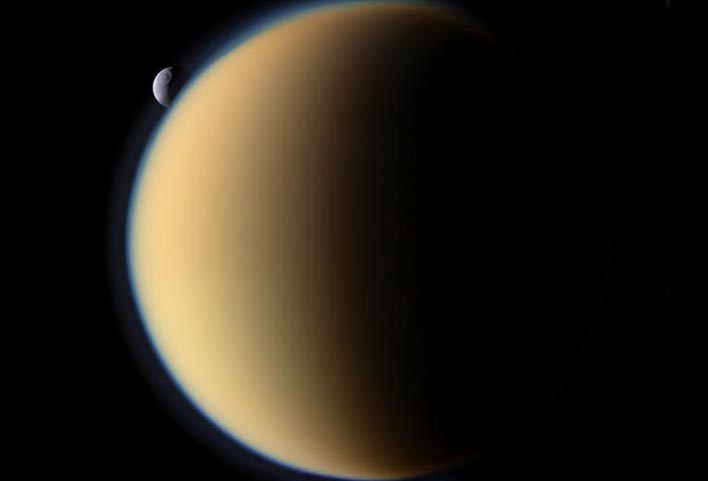
The image above, taken with the Narrow-Angle Camera of the Cassini probe on November 26, 2009, reveals the opaque and orange atmosphere of Titan as well as Tethys beyond, another moon of the Gas Giant Saturn. The action of ultraviolet light in the upper atmosphere of the giant moon engenders complex chemical reactions which produce organics or hydrocarbons such as acetylene or ethylene. The origin of Titan's atmosphere is still a matter of debate and speculation. Image Credit: NASA/JPL-Caltech/Space Science Institute.
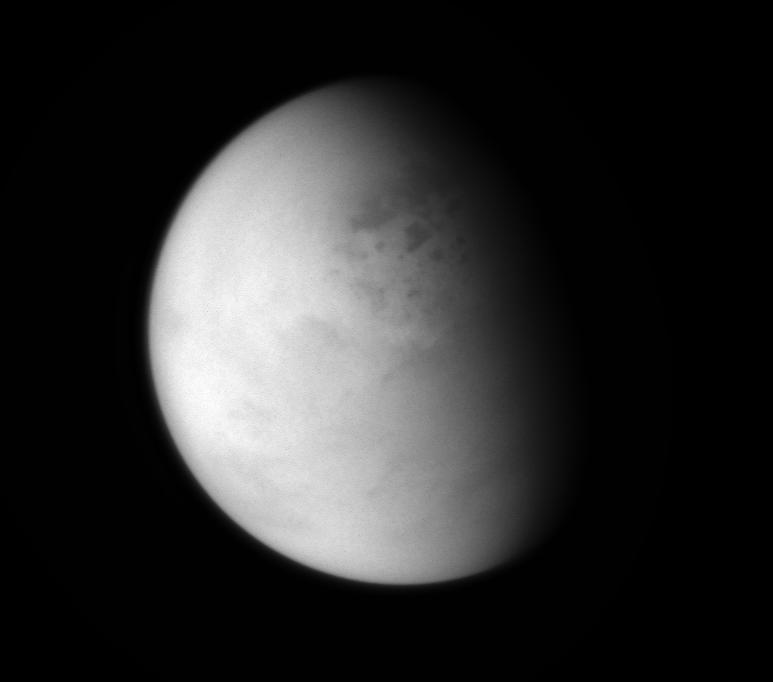
The image above obtained with the Wide-Angle Camera of the Cassini probe on January 1, 2014 clearly reveals the lakes or seas present in the high latitudes of Titan's northern hemisphere. The view was acquired using a spectral filter sensitive to wavelengths of near-infrared light centered at 939 nanometers. The infrared or near-infrared views allow us to discern topographic or surface features. Are the lakes or seas related to internal sources or cryovolcanoes ? Image Credit: NASA/JPL-Caltech/Space Science Institute.
-To get further information on that news, go to: http://www.astrobio.net/news-exclusive/titans-atmosphere-created-gases-escaped-core.
March 3, 2015: A Team of Researchers Involving Jonathan Lunine Modeled Azotosomes, Cell Membranes that May Exist In A Hypothetical Titanian Biosphere
Saturn's largest moon Titan appears to be a captivating world with a remarkably diverse environment. The data acquired from the Cassini spacecraft and from the Huygens probe since their arrival into the Saturn System in mid-2004 have shown that Titan encounters Earth-like processes such as erosion, evaporation, condensation and precipitation.
The radar data obtained with the Radar Mapper of the Cassini spacecraft clearly reveal lakes, seas and rivers in the high latitudes or in the polar regions of the Opaque Moon. The exact composition of the lakes, seas and rivers is still unknown but scientists have been in a position to advance that they are mostly composed of methane and ethane. Methane appears to play a key role in the meteorological cycle.
Since life on Earth is based on a liquid, id est liquid water, scientists and the general public are wondering whether a lifeform may develop in the liquid or damp environments of Titan. In other words, is there a methane-based life or an ethane-based life on Titan ?
The environment of Titan at the level of the surface is devoid of liquid water since the environmental temperature is around -180 degrees Celsius, -292 degrees Fahrenheit or 93 Kelvin. However, methane which represents a significant fraction of Titan's atmosphere can be present in its liquid form in that exotic environment, like ethane and propane. So, if there is life on Titan, it may rather be based on the liquids present on the ground.
Life on Earth is intimately linked to the carbon element and carbon is widespread on Titan. The Titanian atmosphere is mostly composed of molecular nitrogen like the atmosphere of our planet. Therefore, if there is life on Titan, it may be intimately linked to methane and nitrogen.
That's why a team of Cornell University researchers has attempted to study the configuration of an exotic life involving carbon, hydrogen and nitrogen. The team is composed of Paulette Clancy who is a chemical dynamics expert, of James Stevenson who is a graduate student in chemical engineering and of Jonathan Lunine who is director for Cornell's Center for Radiophysics and Space Research.
The group led by Paulette Clancy tried to imagine methane-based, oxygen-free life that could develop and thrive in the harsh environment of Titan. The team managed to theorize methane-based, oxygen-free life forms that can metabolize and reproduce like typical life forms on our planet. The life form the team of Jonathan Lunine imagines, in a logical way, is based on oxygen-free cell membranes.
These exotic cell membranes consist of small organic nitrogen compounds. These cell membranes are likely to resist the harsh environment of liquid methane and to develop or work. The outcome of the work proposed by this team is published in Science Advances on February 27, 2015.
The theory is based on the initiative of Jonathan Lunine, a specialist of Titan and an interdisciplinary researcher on the Cassini-Huygens mission that allowed us to clearly identify the methane-ethane seas on the Orange Moon. Jonathan Lunine is wondering whether an exotic life form could thrive or develop in the liquid environments of Titan.
One of his hypotheses is that methane-based organisms may take shape and thrive on Titan. This fascinating idea pushed him to study non-aqueous life, supported by a grant from the Templeton Foundation. About a year ago, he looked for specialists or potential collaborators from Cornell faculty with a strong knowledge in chemical modeling. Paulette Clancy accepted to follow him in this adventure.
She pointed out: "We're not biologists, and we're not astronomers, but we had the right tools." She added: "Perhaps it helped, because we didn't come in with any preconceptions about what should be in a membrane and what shouldn't. We just worked with the compounds that we knew were there and asked, 'If this was your palette, what can you make out of that ?'".
Biologists know that Terrestrial life is based on liquid water and on the phospholipid bilayer membrane which represents the strong, permeable, water-based vesicle that harbors the organic matter of every cell. The phospholipid bilayer membrane represents a liposome, a structure whose name finds its root in the Greek words "lipos" and "soma" which mean, literally, "lipid body".
Most scientists believe that life can only develop in the Habitable Zone, the area around the star where water can appear in its liquid form. The concept of Habitable Zone is based on the parameter of liquid water. However, if life can emerge from liquid methane or liquid ethane, the Habitable Zone takes a new dimension.
Can we find life or cells based on methane in environments where one finds liquid methane ? That's a question that the engineers of the team have tried to answer by developing their model based on oxygen-free cell membranes called "azotosomes". The Azotosome is composed of nitrogen, carbon and hydrogen molecules, widespread compounds encountered on Titan.
The term Azotosome comes from the French word Azote which means nitrogen. Azotosome is therefore a nitrogen body, a body dominated by the nitrogen element. The researchers were astonished to notice that the molecular body they had developed showed the same stability and flexibility as the conventional liposome found on our planet.
Paulette Clancy and James Stevenson who study, on a regular basis, semiconductors were really surprised to notice this remarkable stability and flexibility of the cells they had modeled. The engineers resorted to a molecular dynamics method which allowed them to select candidate compounds from methane for self-assembly into membrane-like formations.
The most promising molecule or structure they managed to identify is an acrylonitrile azotosome. This acrylonitrile azotosome revealed good stability, a strong resistance to decomposition as well as a flexibility similar to that of phospholipid membranes encountered on our planet. Acrylonitrile, which is a colorless, poisonous, liquid organic molecule used in the production of acrylic fibers, resins and thermoplastics, has already been identified in the hazy atmosphere of Titan.
On the basis of the remarkable result obtained by the team, Paulette Clancy pointed out that the next step is to study how these potential cells would behave in the methane-rich environment and to try to figure out what might be the analogue to reproduction and metabolism in methane-based cells, devoid of any oxygen.
Jonathan Lunine is eager to check whether his theories or models are correct or close to reality. He is fascinated by the idea of "someday sending a probe to float on the seas of this amazing moon and directly sampling the organics." James Stevenson advanced that he was in part inspired by science fiction writer Isaac Asimov who revealed the notion of non-water based life in a 1962 essay, "Not as We Know It."
He concluded: "Ours is the first concrete blueprint of life not as we know it." The lakes, seas and rivers on Titan are likely to tell us a lot about the way any lifeform develops and whether life can only be based on liquid water.
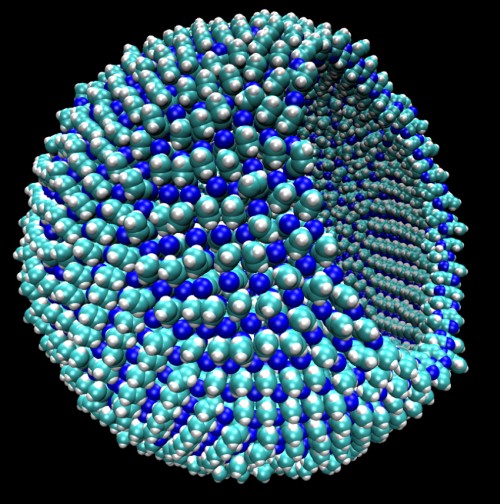
The diagram above reveals the structure of a 9-nanometer azotosome which is roughly the same size as a typical virus. The azotosome is represented as a sphere with a hollow interior and a membrane composed of nitrogen, carbon and hydrogen, elements which are widespread on the Orange Moon. In the diagram, a portion of the membrane has been removed to unveil the hollow interior of the azotosome. Image Credit: James Stevenson.
The artist's representation above reveals a submarine exploring the famous Titanian sea Kraken Mare. Exotic organisms composed of oxygen-free cells or azotosomes can be noticed on the sea floor. The lakes, seas and rivers in the north polar region are likely composed of a mixture of methane and ethane. Image Credit: Marc Lafferre, 2015.
-To get further information on that news, go to: http://www.astrobio.net/news-brief/life-not-know-possible-saturns-moon-titan.
February 14, 2015: Researchers Resort to a New Technique to Handle and Remove the Noise in Titan's Radar Images And to Produce Clearer Views of the Topography
Since the arrival of the Cassini-Huygens spacecraft into the Saturn System in mid-2004, the Radar Mapper has obtained multiple radar images or swaths of Titan's landscape revealing the remarkable diversity of the landscape from the equator to the polar areas.
Until now, the Radar Mapper of the Cassini probe has mapped nearly half of the surface of the Orange Moon. The Radar Mapper is probably the best instrument to obtain key data on the landscape because the deep, thick and opaque atmosphere represents a smoggy veil which prevents us from directly discerning landscape features from outer space.
In other words, the landscape can't be seen in the visible spectrum from the Cassini probe. Surface features on Titan can be discerned in the infrared or near-infrared spectrum. The Visual and Infrared Mapping Spectrometer or VIMS of the Cassini probe has gathered numerous infrared or near-infrared data of Titan's landscape and it represents a good complementary tool to the Radar Mapper.
On the basis of infrared, near-infrared and radar data, scientists are in a position to determine or to better analyze the nature and the shape of surface features on the Opaque Moon. The VIMS instrument has revealed that there are bright and dark regions in the near-infrared spectrum. The radar instrument has allowed us to determine that the dark areas found at low latitudes are dominated by Seif Dunes or parallel and linear dunes which extend over long distances.
The VIMS and radar data have also revealed the presence of lakes, seas or rivers in the high latitudes. The lakes, seas and rivers appear to be mostly concentrated in the north polar region where a meteorological cycle involving hydrocarbons takes shape. The lakes, seas or rivers may be mostly composed of methane and ethane.
The Radar Mapper has gathered key data upon the topography of the Orange Moon but the radar images presented since the beginning of the Cassini mission show a strong noise which makes them difficult to interpret or analyze. That's why a new technique called the "Despeckling Technique" has been recently developed.
The Despeckling Technique allows scientists to handle and remove the electronic noise of radar images obtained from the Radar Mapper of the Cassini spacecraft. Thus, researchers and the general public can benefit from clearer views of the landscape which becomes easier to interpret or analyze.
The Despeckling Technique is based on an algorithm which has the power to modify the noise or the characteristic grainy appearance of the original radar images. The grainy appearance or the speckle noise tends to make the study of small-scale features hard. Likewise, this electronic noise tends to prevent researchers from correctly identifying changes in views of the same area acquired at different times. The radar images are remarkably clearer when the despeckling treatment is applied.
The Despeckling Technique has been developed thanks to the initiative of Antoine Lucas, a former postdoctoral researcher at the California Institute of Technology in Pasadena. Antoine Lucas who is now working at the astrophysics division of France's nuclear center, the CEA or "Commissariat à l'Energie Atomique" developed the idea to implement this new de-noising technique while collaborating with members of Cassini's radar team.
He pointed out: "Noise in the images gave me headaches." He was convinced that he could use pre-existing mathematical models to handle and remove the electronic noise or the grainy appearance of Titan's radar images. The goal was simply to obtain smooth, progressive or uniform landscape features which are ipso facto easier to interpret or analyze.
Antoine Lucas tried to find ad hoc mathematical models or research works published by mathematicians or scientists who are somewhat working in a different field of studies. He eventually managed to identify a team near Paris who was developing a "de-noising" or despeckling algorithm. He started to collaborate with the group of researchers to adapt their mathematical model to the radar data taken from the Radar Mapper of the Cassini probe.
The collaboration led to the emergence of the Despeckling Technique which is clearly an innovative analysis technique. Antoine Lucas argued: "My headaches were gone, and more importantly, we were able to go further in our understanding of Titan's surface using the new technique." The Despeckling Technique has not yet been applied to all the radar swaths or images of Titan's surface because the technique implies a lot of computation. Researchers need to determine priorities and to select the most relevant radar views for the despeckling process.
Randy Kirk who is a Cassini radar team member from the U.S. Geological Survey in Flagstaff, Arizona pointed out: "This is an amazing technique, and Antoine has done a great job of showing that we can trust it not to put features into the images that aren't really there." He insisted on the fact that the radar team would have to select by priority the most relevant radar images for the innovative de-noising process. He concluded: "It takes a lot of computation, and at the moment quite a bit of 'fine-tuning' to get the best results with each new image, so for now we'll likely be despeckling only the most important -or most puzzling- images."
The despeckling or de-noising treatment of radar images allows us to obtain clearer views, more progressive brightness variations and it enables scientists to produce 3-D maps or digital elevation maps of the topography of the Orange Moon with a significantly higher quality. That's what Antoine Lucas and his collaborators have clearly demonstrated.
The landscape features, the mountains, the hills, the networks of river channels, the lake shorelines or the windswept dunes appear clearer and become easier to analyze. Some dynamic processes like erosion, cryovolcanic flows or river flows can be better studied or understood. Antoine Lucas believes that even the speckle noise of radar images, when studied separately, can bring information about properties of the ground and the underground.
Stephen Wall who is a deputy team lead of Cassini's radar team, working at NASA's Jet Propulsion Laboratory in Pasadena, California advanced: "This new technique provides a fresh look at the data, which helps us better understand the original images." He added: "With this innovative new tool, we will look for details that help us to distinguish among the different processes that shape Titan's surface."
The Despeckling Technique has allowed us to clearly identify geomorphological data such as rivers flowing down toward a lake or sea, bays or irregular coastlines. Details about this innovative de-noising technique were released recently in the Journal of Geophysical Research: Planets. The despeckling process of radar images may help researchers determine the evolution or the dynamics of lakes, seas and rivers. It may also help them better understand the dynamics of the methane cycle and meteorological or seasonal phenomena.
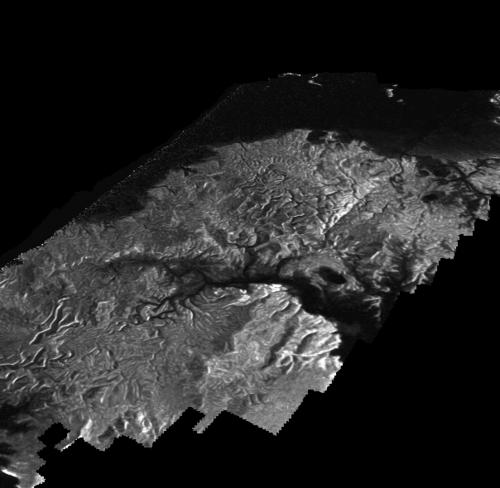
The radar image above corresponds to a perspective view of the area of Kraken Mare obtained during a flyby of Saturn's largest moon Titan on April 10, 2007. The image was produced on the basis of the Despeckling Technique which allows researchers to handle and remove the original noise present in radar images obtained from the Radar Mapper of the Cassini probe. Thus, landscape features become easier to analyze. Image Credit: NASA/JPL-Caltech/ASI.
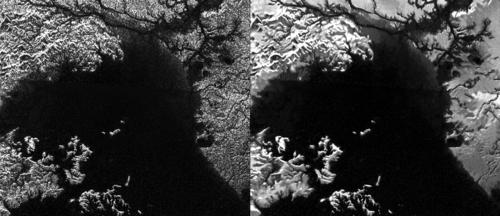
The mosaic above, composed of radar images, shows the area of Ligeia Mare. The view on the left of the mosaic corresponds to the traditional radar image and the view on the right of the mosaic represents the same view in which the innovative despeckling treatment has been applied. The view is clearer and easier to study. Image Credit: NASA/JPL-Caltech/ASI.
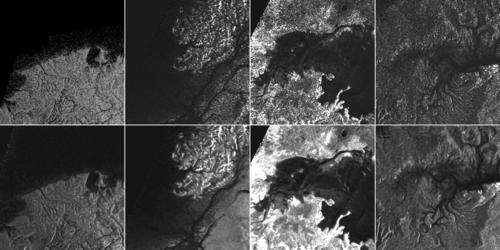
The mosaic above shows several radar images of Titan's landscape. The images in the upper row of the mosaic correspond to traditional radar images and the views in the lower row of the mosaic correspond to the same radar images in which the new despeckling or de-noising technique has been applied to make the topography clearer and easier to analyze. The three views from the left of the mosaic show bays and spits in Ligeia Mare and the view in the right part of the mosaic reveals a valley network along Jingpo Lacus. Image Credit: NASA/JPL-Caltech/ASI.
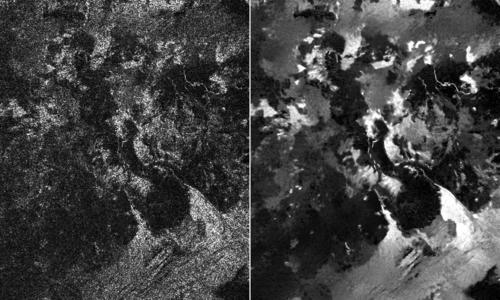
The mosaic above shows the area of Leilah Fluctus, a famous landscape feature on Titan. The bright cone-shaped features of Leilah Fluctus can be clearly discerned here. The view on the left corresponds to a traditional radar image obtained from the Radar Mapper of the Cassini probe. The view on the right corresponds to the same image in which the despeckling treatment has been applied to handle and remove the electronic noise. Landscape features become easier to analyze. Image Credit: NASA/JPL-Caltech/ASI.
| The image in the upper part of the table corresponds to
a simulated view of the area of Ligeia Mare based on a radar image of
the area in which the innovative despeckling treatment has been applied.
The view in the artist's rendering is taken from a virtual camera and
the landscape is generated via the Shape From Shading Technique. The
virtual camera is orientated from the lake or sea Ligeia Mare toward a
network of drainage channels fuelling the lake or sea. The location and
the orientation of the virtual camera are indicated by a grey arrow in
the radar view shown in the lower part of the table. The original radar
image was acquired from the Radar Mapper of the Cassini probe.
Credit for the artist's rendering:
Marc Lafferre, 2015. |
- To get further information on that news, go to: http://saturn.jpl.nasa.gov/news/cassinifeatures/feature20150211.
January 30, 2015: Some Researchers Find that Titan's Interaction With the Supersonic Solar Wind Outside Saturn's Magnetosphere Resembles That of the Unmagnetized Bodies Venus and Mars
Titan has always surprised scientists due to its deep, thick and opaque atmosphere. Most moons in the Solar System are devoid of any atmosphere. Titan which is a little bit smaller than Jupiter's moon Ganymede is covered with a deep atmosphere mainly composed of molecular nitrogen and methane. The Huygens probe which landed onto the surface of the Orange Moon on January 14, 2005 recorded an atmospheric pressure of 1467 hPa on the ground.
Scientists are trying to understand the dynamics of Titan's strange atmosphere and they are also trying to determine why Titan has kept a significant atmosphere over time whereas the giant moon Ganymede is devoid of any significant atmosphere. Some researchers have advanced that Saturn's magnetosphere which encompasses most of the time the orbit of Titan may have played a key role in the stability of Titan's atmosphere over time.
The magnetic field of a Solar System body is likely to act as a shield against the action of ionized particles or solar wind. It appears that Saturn's largest moon Titan spends approximately 95 percent of the time within the magnetic field of the Gas Giant Saturn. But Cassini researchers have had the opportunity to study the interaction between Titan's atmosphere and the supersonic solar wind in a configuration in which Titan was evolving outside Saturn's magnetosphere. This rare and transient configuration took shape during a flyby of the Orange Moon in December 2013. It was in fact the only time the Cassini probe had seen the Opaque Moon in a pristine state, in an area outside the giant magnetic field of Saturn.
A study upon the interaction of Titan and its atmosphere with the supersonic solar wind published in the journal Geophysical Review Letters and entitled "Titan's interaction with the supersonic solar wind" was proposed by a Cassini team led by Cesar Bertucci of the Institute of Astronomy and Space Physics in Buenos Aires. Cesar Bertucci pointed out: "We observed that Titan interacts with the solar wind very much like Mars, if you moved it to the distance of Saturn." He added: "We thought Titan in this state would look different. We certainly were surprised."
The solar wind is made of charged particles like ions, electrons or protons which move at an extremely fast speed from the Sun. Solar eruptions, solar flares or Coronal Mass Ejection produce solar winds which will interact with bodies encountered in space. The magnetic field of Jupiter and Saturn tends to deflect the solar wind and to protect their atmosphere. The shield represented by the magnetosphere acts, to a certain extent, like an island in a river.
Researchers try to better understand the influence of the solar activity, of the solar radiations and of the solar wind on the dynamics and on the composition of the atmosphere of Saturn and Titan in particular. The composition or the chemistry of the atmosphere may be closely related to the action of solar particles or compounds such as UV light, protons, electrons and ionized particles. The solar wind is likely to blow away an atmosphere or to engender the progressive loss of an atmosphere. Therefore, the atmosphere can be preserved or maintained if there is a significant magnetosphere around the planet or moon.
Most of the time, Titan's atmosphere benefits from the protective shield of Saturn's magnetic field but on December 1, 2013 during the Cassini flyby of Titan, the Opaque Moon appeared outside Saturn's magnetosphere, thanks to a powerful outburst of solar activity which had produced a significant increase in the solar wind. Titan appeared to move on the sunward side of the Gas Giant Saturn and the rise in the solar wind pushed and compressed the Sun-facing side of Saturn's magnetosphere.
As a result, the boundaries of the magnetic bubble around Saturn appeared closer to Saturn and inside the orbit of the Orange Moon. Scientists had the opportunity to analyze the interactions between the strong stream of energetic solar particles and the atmosphere of Titan in a configuration in which the giant moon is directly exposed to the solar wind without the protective action of Saturn's magnetosphere.
Since the beginning of the Cassini-Huygens mission in mid-2004, the Cassini probe has gathered a large amount of data from Titan during multiple flybys but the Opaque Moon was always within the magnetic field of Saturn. The magnetometer instrument of the Cassini spacecraft which is similar to an extremely sensitive compass has not allowed researchers to identify a magnetic field generated by Titan.
Does the giant magnetic field of Saturn erase the hypothetical weak magnetic field of Titan ? Researchers had a unique opportunity in December 2013 to verify whether Titan had a proper magnetic field because Titan was temporarily outside Saturn's magnetosphere. They also had the opportunity to analyze the interactions between the solar wind and Titan's atmosphere, on the basis of the magnetometer, without the influence of Saturn's magnetosphere.
Cesar Bertucci and his collaborators took advantage of the unusual configuration to study the shockwave that took shape around the Orange Moon where the strong and supersonic solar wind collides with the Titanian atmosphere. The team of Cesar Bertucci has been in a position to perform a comparative analysis of the interactions between the solar wind and the atmosphere for Titan, Venus, Mars and comets.
Venus, Mars and comets are known to be devoid of any proper magnetic field. The researchers noticed that the interactions between the solar wind and the atmosphere are similar. The solar wind drapes around the celestial bodies, interacting directly with their atmosphere or gas blanket. In the case of a comet, the solar wind will tend to drape around the coma.
Our planet is in a different configuration simply because it generates a powerful magnetic field around it. Therefore, the magnetosphere acts as a deflector, an obstacle or a shield against charged particles from the Sun. It has a protective effect on the atmosphere and it keeps it from being stripped away by the solar wind.
The team of Cesar Bertucci was really surprised to observe similar configurations between Titan, Venus or Mars because the atmosphere of Titan is hazy, dense, deep and highly complex. Cesar Bertucci advanced: "This could mean we can use the same tools to study how vastly different worlds, in different parts of the solar system, interact with the wind from the sun." According to him, the dwarf planet Pluto may obey the same pattern of interactions as Titan since it may be an unmagnetized dwarf planet. We'll see in a few months with the New Horizons probe.
Michele Dougherty, principal investigator of the Cassini magnetometer at Imperial College, London underlined: "After nearly a decade in orbit, the Cassini mission has revealed once again that the Saturn system is full of surprises." She concluded: "After more than a hundred flybys, we have finally encountered Titan out in the solar wind, which will allow us to better understand how such moons maintain or lose their atmospheres."
We know that the radiations from the Sun play a key role in the complex chemistry of Titan's atmosphere but the role of Saturn's magnetosphere in the dynamics of Titan's atmosphere is a matter of debate. Without the magnetosphere of Saturn, would Titan still have a significant atmosphere ?
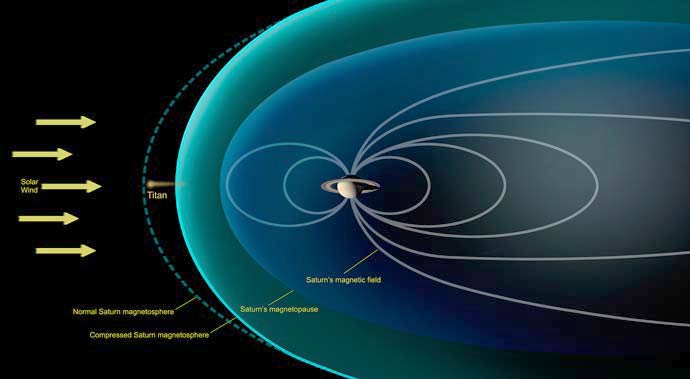
The diagram above shows the way the magnetic field of Saturn interacts with the solar wind. Titan is normally inside Saturn's magnetosphere but during the Cassini flyby of December 1, 2013, Titan appeared beyond the boundaries of the huge magnetic field of Saturn because a strong solar wind had pushed and strongly compressed Saturn's magnetosphere so that Titan which was moving between the Sun and Saturn was not protected anymore by the magnetic field of Saturn. It was of course an exceptional configuration and scientists have seized the opportunity to analyze how the charged particles from the Sun had interacted with the Titanian atmosphere. Image Credit: NASA/JPL-Caltech.
| The image in the upper part of the table shows a simulated view of Titan and Saturn on December 1, 2013 when the Opaque Moon appeared, exceptionally, outside Saturn's magnetosphere due to the action of a strong solar wind which had pushed and compressed the magnetic field of Saturn. The Cassini flyby of Titan allowed scientists to analyze the interaction of the solar wind with Titan's atmosphere. The view in the lower part of the table corresponds to the same view with annotations on the name of the celestial bodies which can be seen in the image. The simulated view was obtained with the software Celestia. The texture for Titan was generated by Marc Lafferre. Image source: Celestia. Credit for the artificial texture of Titan: Marc Lafferre, 2015. |
- To get further information on that news, go to: http://saturn.jpl.nasa.gov/news/newsreleases/newsrelease20150128.
Titan News 2014
Titan News 2013
Titan
News 2012
Titan
News 2011
Titan
News 2010
Titan
News 2009
Titan News 2008
Titan
News 2007
Titan
News 2006
Titan News
2004, 2005
